Many plants make pollen (but not all). Knowing what these plants are and how to care for them means a richer garden with plenty of insects and wildlife stopping by. But what are some plants that make pollen?
The following plants make pollen (among others):
- Coneflower
- Lavender
- Aster
- Calendula
- Salvia
- Celosia
- Zinnia
- Borage
- Foxglove
- Nasturtium
- Sunflower
- Snapdragons
- Chives
- Mustard
- Snowdrop
- Crocus
- Sweet clover
- Blackberry
- Raspberry
- Blueberry
- Marigold
- Heather
- Thistle
- Cucumber
- Melons
- Pumpkin
- Lupin
- Buckwheat
- Blue vine
- Basil
- Poppy
- Mallow
- Cat Tail
- Ivy
- Goldenrod
- And a variety of trees too
Do All Plants Produce Pollen?
When you think of pollen, I’d imagine your mind would instantly go to flowering plants. Most flowering plants indeed produce pollen, but not all members of the same species do this.
The male part of the plant (the stamen, within which is the anther that makes the pollen) produces pollen. To start the reproductive process in plants, something has to transfer this pollen from the stamen to the female part of another plant (the stigma).
While some species have male and female parts, many flowering plants are male or female.
There are even flowering plants that do not make pollen at all, such as the coastal spinifex, a flowering plant found around the coastlines of Australia, New Zealand, the Middle East, Asia, and parts of Africa.
Some trees and plants without flowers may produce cones instead, which can also produce pollen. One of the most well-known examples of this is the conifer. The conifer’s male cones produce pollen, and they look like bunches of corn puffs grouped together.
If you’re allergic to pollen but still want a blooming garden, it’s usually best to choose female plants, as these will not produce this powdery, yellow allergen.
Why You Want Pollen Plants In Your Garden
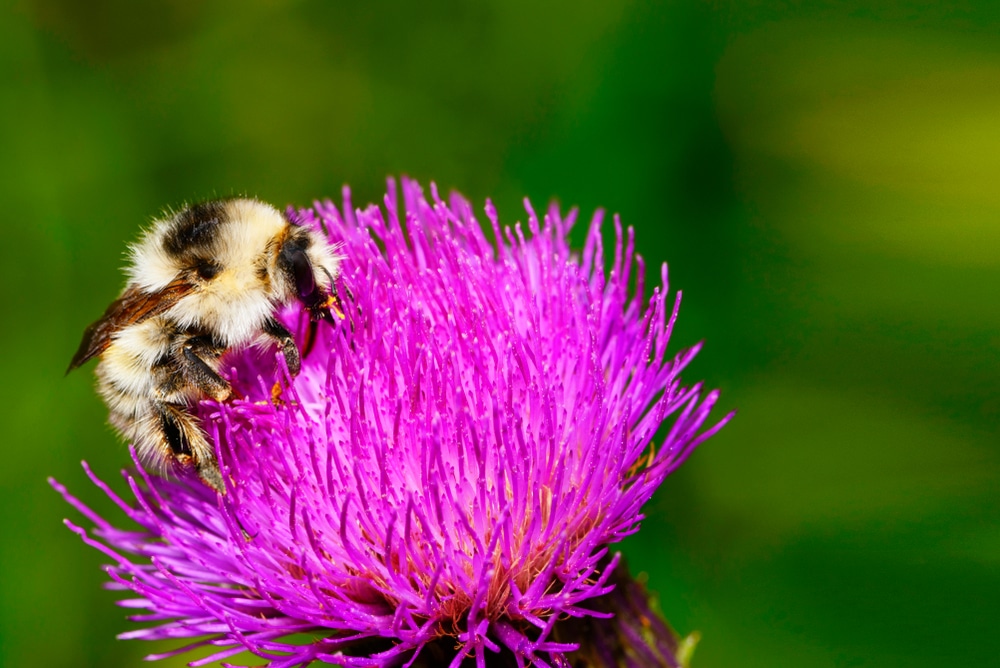
Insects and animals known as pollinators often spread pollen. They (usually inadvertently) take pollen from one plant to another as they feed on nectar.
Pollination is essential to ensure the survival of wildflowers, fruit trees, and many species of crops.
But our pollinators need a food source if they are going to do their job effectively. That means having pollen plants in your garden.
By including these plants, you’re not only providing these critters with food, shelter, and habitat, but you’re also playing your part in ensuring the pollination of local species.
Is There Such A Thing As Bad Pollen?
It’s very common for humans (and some animals) to be allergic to pollen. This doesn’t necessarily mean pollen is bad, but it can cause a nasty reaction.
I have suffered from a tree pollen allergy for my entire life, and it usually presents as a runny nose, itchy eyes, difficulty breathing, and skin rashes. However, you can usually reduce these symptoms by taking over-the-counter medication (consult your doctor first).
That said, there are some plant species whose pollen contains toxic compounds that kill any visiting pollinators.
The death camas is an excellent example of this. While it may have a similar appearance to the common camas, these plants have pollen that contains a toxin known as zygadenine. This is a steroid-alkaline compound that kills pollinators who dare eat it.
I also wouldn’t recommend having this plant as the pollen is known to cause symptoms and even death in humans due to hypotension (low blood pressure).
You might think this seems counterproductive as plants rely on pollinators to reproduce. However, some plant species have only pollinators specializing in pollinating that plant.
In the case of the death camas, the only insect that can successfully pollinate it is the death camas bee. The benefit for the flower is guaranteed pollination, which general pollinators can’t provide.
How To Care For Pollen Plants In General
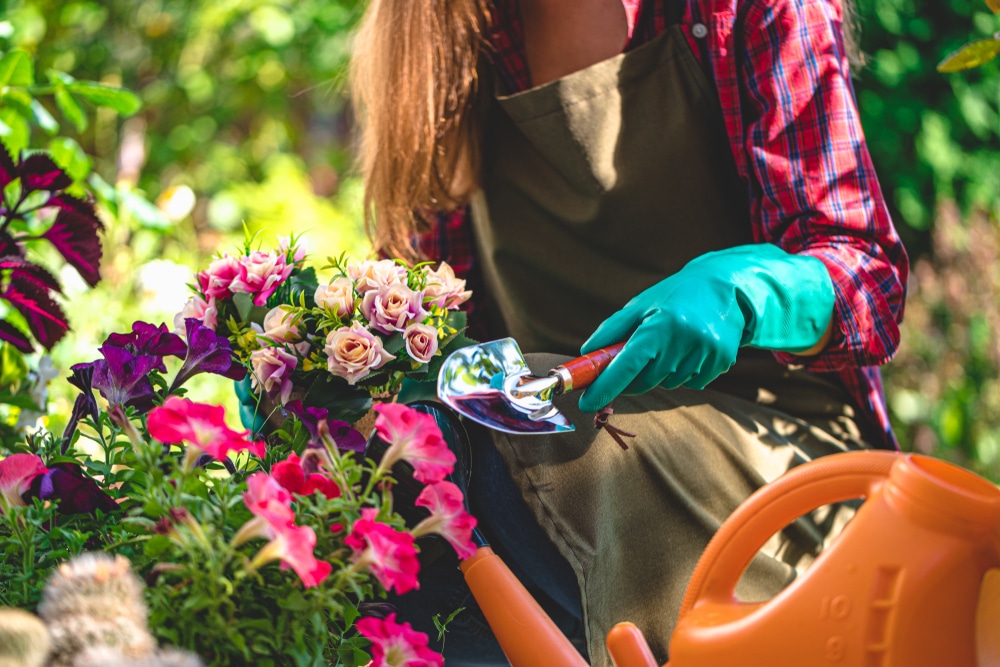
Keeping pollen plants can involve lots of steps. Each plant will have its own requirements, including how much sunlight it needs, how frequently you need to water it, what type of soil it requires, and so forth.
It’s, therefore, imperative to check your plant’s care label so you can confidently provide it with everything it needs.
Also, when caring for pollen plants, you may need to give them a helping hand during pollination season. While many insects and animals will come to your garden (and some plants even rely on wind and water pollination), it’s not always guaranteed.
Gardeners can remove pollen from one plant by hand and place it on the stigma (female part) of another of the same species at times when natural pollination is unlikely.
It’s best to do this when the flower naturally opens. With most species, this will be in the morning, but night-blooming plants open in the late afternoon and evening.
You can take a cotton swab or small paintbrush and gently rub this over the stamen (male part) to remove some pollen. Then gently rub the swab or paintbrush against the stigma of another plant. It’s also possible to rub two flowers of the same species together.
What Plants Make Pollen (And How To Care For Them)?
The beauty of pollen plants is there are so many to choose from. Regardless of where you live, what the climate is like, and what space you have, there will be a species of pollen plant that you can care for.
The list below won’t cover all of those, but these are a good start.
A Quick Note About Edible Plants
Before I get started, I’d also like to mention some plants on this list are edible. When preparing a plant for eating, you’ll need to first check which parts you can consume. In most cases, it’ll be the fruits or seeds, but there are some species whose leaves, flowers, and even stems can be eaten.
Any part of the plant you take for food should be thoroughly washed, and you should also check whether the parts need cooking. With some plants, like mustard and kale, the leaves can be very bitter and fibrous if they’re not boiled or blanched before eating.
1 – Coneflowers

Coneflowers, sometimes called echinacea, are super rich in pollen, so they are ideal for attracting pollinators. They boast gorgeous red, orange, or pink flowers that will increase in size year after year.
They are perennial plants, meaning they live for longer than two years. They’re also straightforward to care for.
Coneflowers require regular watering, usually around one inch each week. However, give them a little more during long periods of drought. Moreover, giving your coneflowers a little extra water in winter can help prepare them for the growing season.
You’ll need to place the plant in a warm, sunny spot, especially over winter, and cut back the flowers during the fall.
To boost the plant’s growth, apply a light layer of compost to keep nutrients in the soil and improve drainage.
2 – Lavender
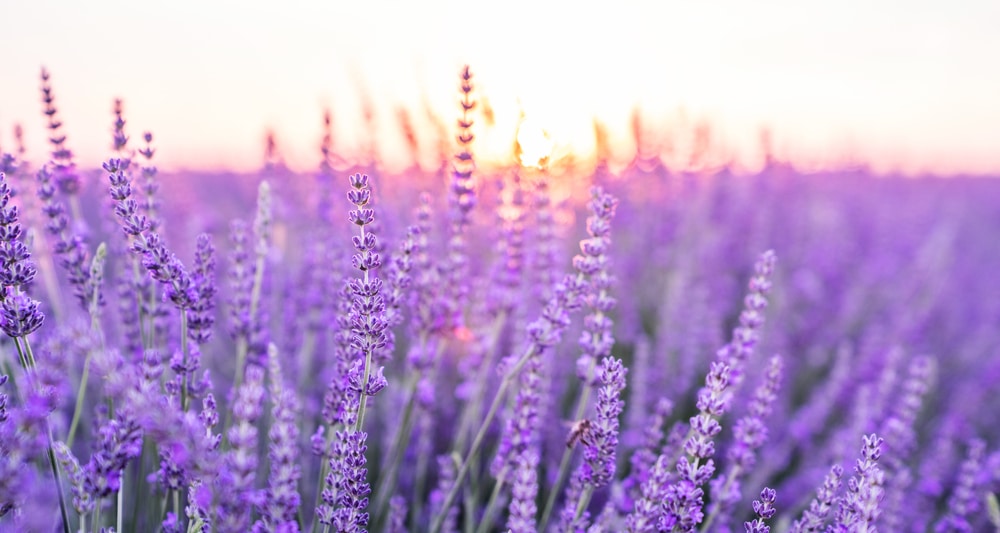
I’m a huge lavender fan. I’ve seen many bees buzzing around for the last couple of years since I’ve had a lavender plant in my garden. Lavender plants are also highly fragrant. You can even add lavender to sweet dishes for an earthy flavor.
A great thing about lavender is that it’s pretty easy to keep because it’s so resilient. In other words, it’ll thrive if you grow the plant in a sunny spot with well-draining soil. But be careful. If the soil is too wet, this can cause root rot.
Planting in a raised bed or container can help in areas where the soil is too moist. You’ll also need to prune the plant in early spring to encourage healthy growth.
3 – Asters
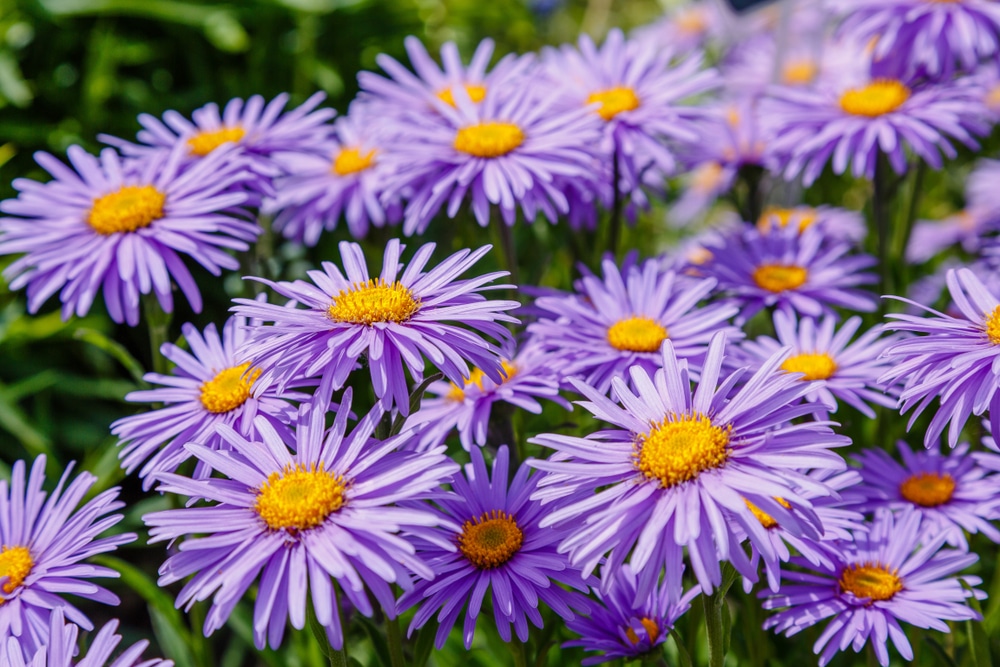
By planting plants from the aster family, you’ll notice an abundance of bees and butterflies. These plants produce beautiful bright flowers in mid-to-late summer and don’t have an overly strong aroma if you don’t want something too potent.
Asters will continue to flower until fall, but this will only happen if you regularly deadhead (remove dead flowers) the plant. They tend to thrive in cool, moist climates and prefer a partially sunny spot.
It’s worth noting these plants are very sensitive when it comes to watering; too much or too little can cause problems. Give them around an inch of water each week. If this is provided by rainfall, you won’t need to do anything.
When planting your asters, do this in late spring to avoid any chance of frost, which could damage them.
4 – Calendula
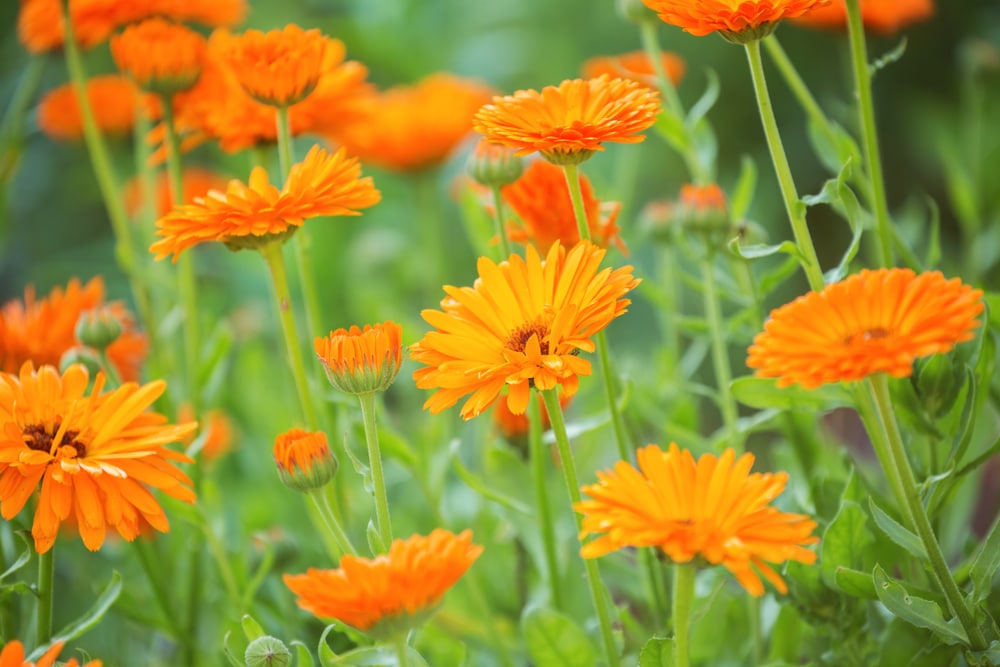
Calendula is in the marigold family. It’s a wonderful choice for people growing crop plants as it’s excellent at attracting natural predators like ladybugs, which will control the pest populations in your garden.
With deep orange-colored flowers that bloom from early summer all the way through to fall, calendula is really easy to care for as it is tolerant even of poor conditions. What’s more, you can eat the flowers! I’d advise picking them as this encourages even more to bloom.
If you’re planting seedlings, give them around 18 inches of space between plants and avoid overwatering them. They typically need just an inch to an inch and a half of water each week.
5 – Salvia
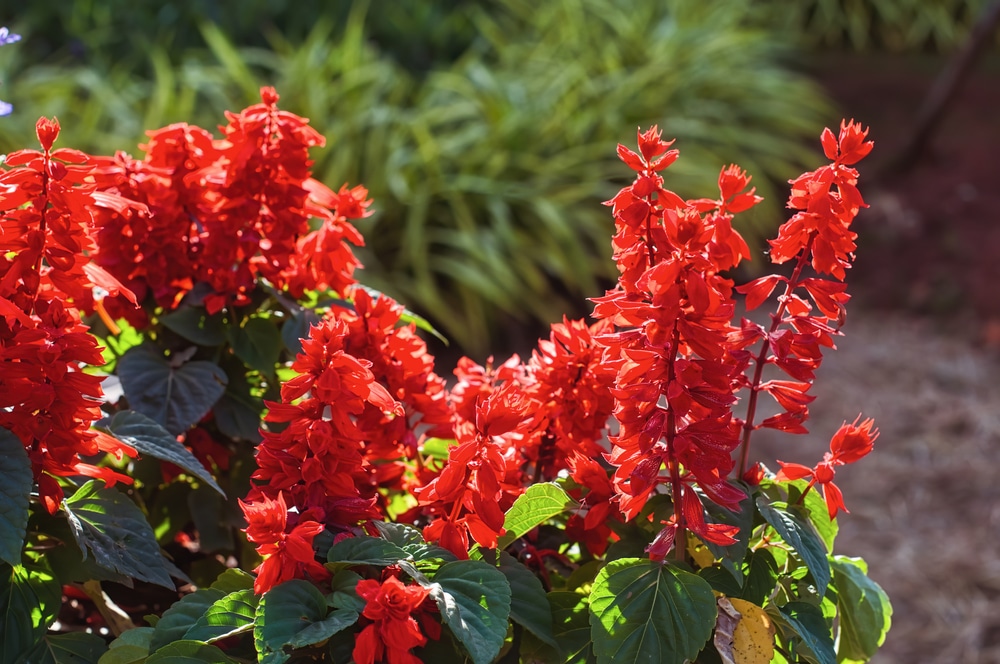
Salvia produces stunning blue flowers on long stems. This is the perfect plant if you don’t have a lot of space. You can pot it on a balcony in a sunny spot, for example. The benefit of growing salvia in a container is you have much better control of the soil quality, which should be well-draining.
These plants typically flower around the middle of summer. When the blooming period is over (which can last until the first frost), cutting the stems back to the base is essential. You’ll then need to prune the plant again in spring.
6 – Celosia
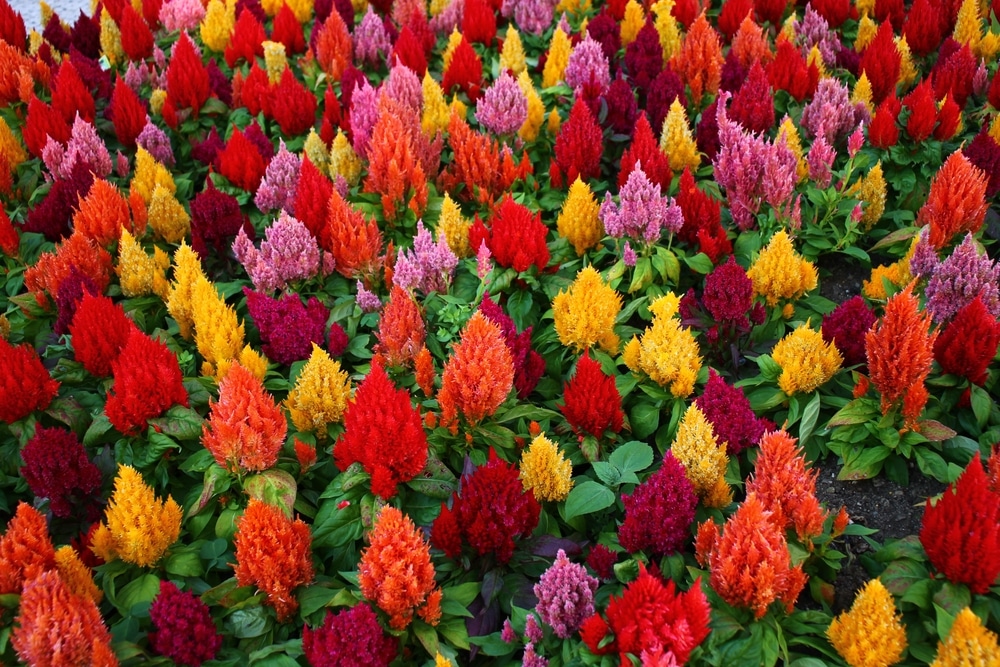
Celosia is a great plant if you want a talking point in your garden since it has an unusual shape. What’s more, they’re high pollen producers and continue flowering until fall, providing pollinators with a food source until the first frost.
Sometimes called cockscomb or wool flowers, celosia is relatively easy to care for. You can grow it in pots, which is ideal if you’re short on space.
Celosia does not need light when planting from seeds. However, once grown, these plants prefer a sunny spot. Place them in very well-draining soil, as they will not tolerate wet roots. If you care for them properly, they’ll reward you with edible leaves that contain many of the same nutrients as leafy greens!
7 – Zinnia
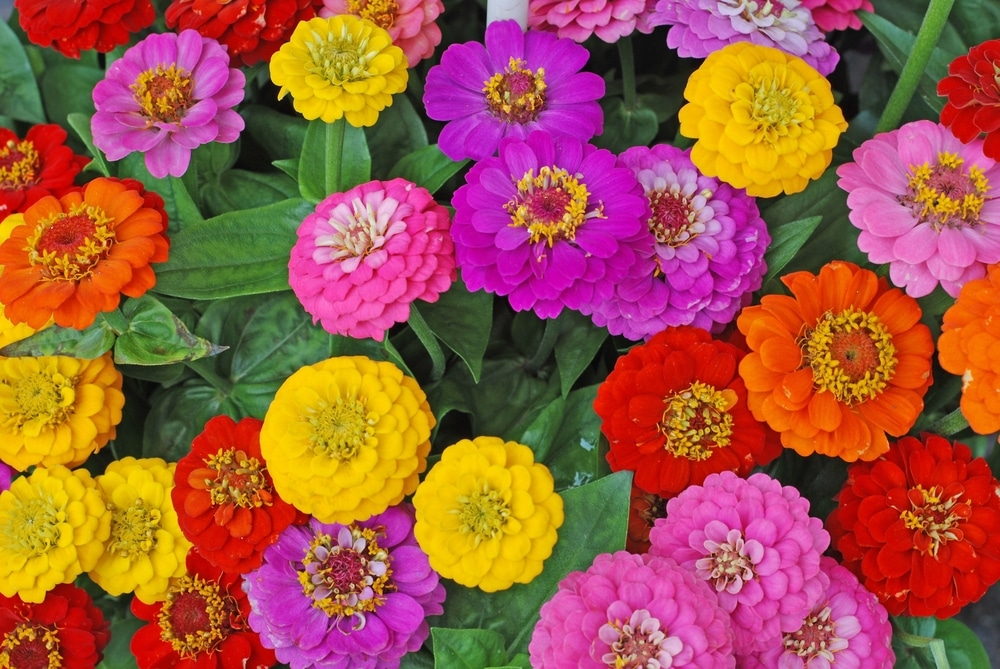
Zinnias produce a lot of pollen, and they’re stunning to look at. Pollinators love them for their bright pink petals and constant nectar supply.
Remember that zinnias are very thirsty plants, so staying on top of watering is vital. They also require a spot in full sun. However, doing all this work rewards you with blooms from mid-summer to fall.
As an annual plant (plants that live and die within one growing season), zinnias won’t survive the winter, but you’ll get a good run out of them, especially if you regularly deadhead the plant.
8 – Borage
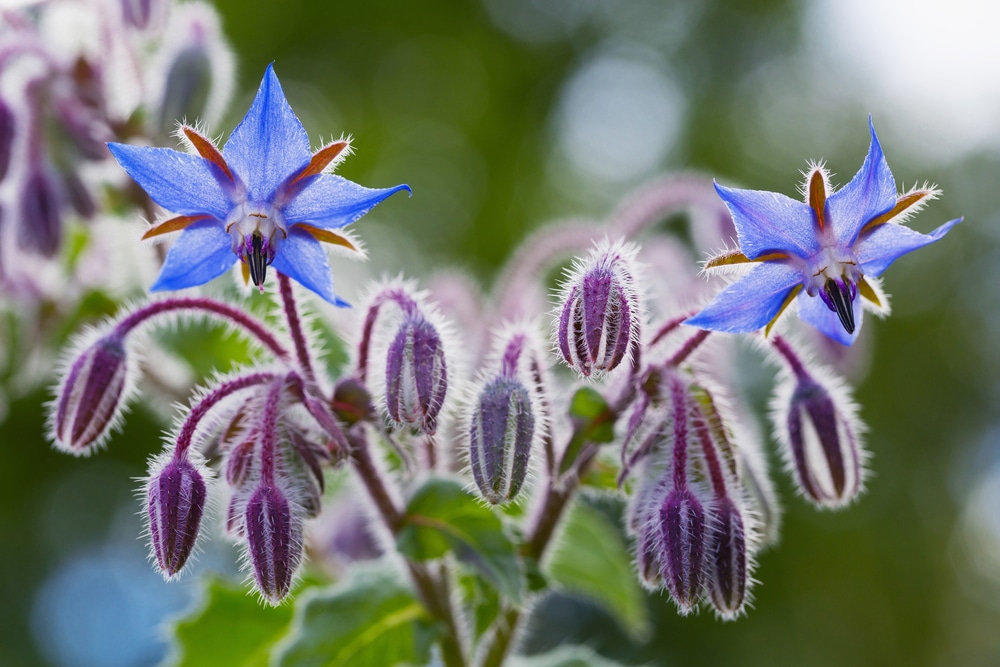
Borage is one of the best plants to attract bees to your garden as they constantly produce nectar. Borage is also the perfect natural pest controller.
If you want those beautiful blue star-shaped flowers to bloom to their best, you’ll need to plant them in a spot with at least half a day’s worth of sun. The soil should be well-drained, and you’ll need to prune the plant around October or November.
Being an annual plant, most gardeners will dig up borage once the flowering period is over and compost it, as it makes excellent fertilizer.
9 – Foxgloves
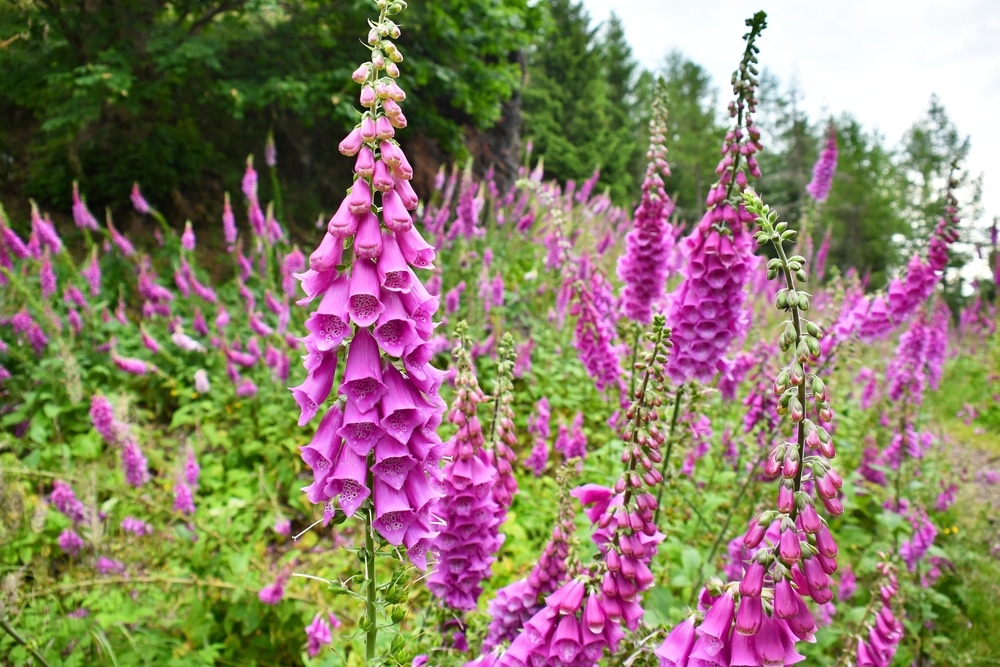
One of the great things about foxgloves is that they’re completely beginner friendly. Once the plants are established (they start showing new growth, and you can reduce your level of care – similar to how babies begin taking care of things on their own), they will typically look after themselves. You’ll need to plant seedlings around 12-14 inches apart and water them well to achieve this.
What’s more, they’re effortless to grow from seed. Just make sure you keep the soil moist until the seeds germinate.
Sow the seeds in the late summer or at the beginning of fall, and by spring and your garden will bloom with pretty trumpet-shaped purple flowers. These flowers are highly attractive to pollinators like bees and hummingbirds.
While these plants are pretty drought tolerant, they do like moist soil. I planted some foxgloves at the back of my garden in a sunny spot, and they’ve thrived for three years. Snow thimble and regal red are some of the best perennial varieties.
10 – Nasturtium

A climbing plant (a plant that climbs up tall things like trees or walls), nasturtium rewards gardeners with gorgeous bright orange flowers. They’ll attract all kinds of insect pollinators and are incredibly easy to care for.
I strongly recommend nasturtium if you’re looking for a low-maintenance pollen plant. These plants will do very well if you plant them in free-draining soil and receive sunlight for at least half of the day.
Sow your seeds between March and May, but remember, these plants will not tolerate frost. If you expect freezing conditions, prune the plant and move it indoors or use a horticultural fleece (protective covering).
11 – Sunflower
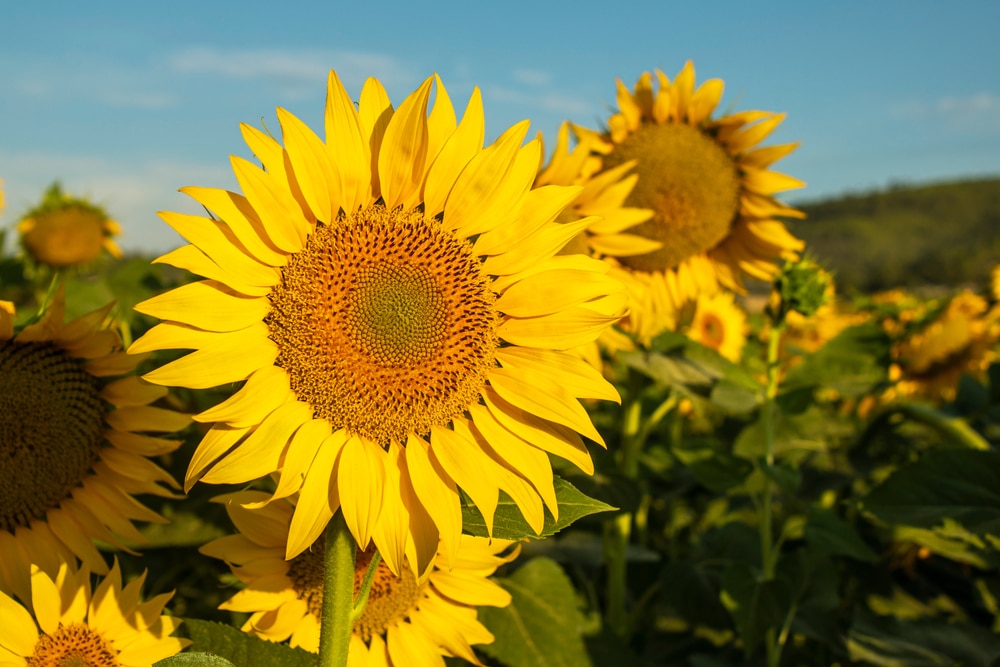
Sunflowers are often the pride of the garden with their bright yellow petals, enormous height, and beautiful array of brown seeds at the center. They’re also ideal for attracting pollinators.
If the growing season is short, it’s best to plant sunflowers indoors, but if the frost has passed at the beginning of spring, it’s fine to plant outdoors.
You’ll need to water the plant well until it is established. It’ll need support once it grows more than three feet tall. Some sunflowers can even grow to more than 16 feet tall!
These plants grow well in all soil types, but they must get at least six hours of sun daily, so make sure you choose the right spot!
12 – Snapdragons
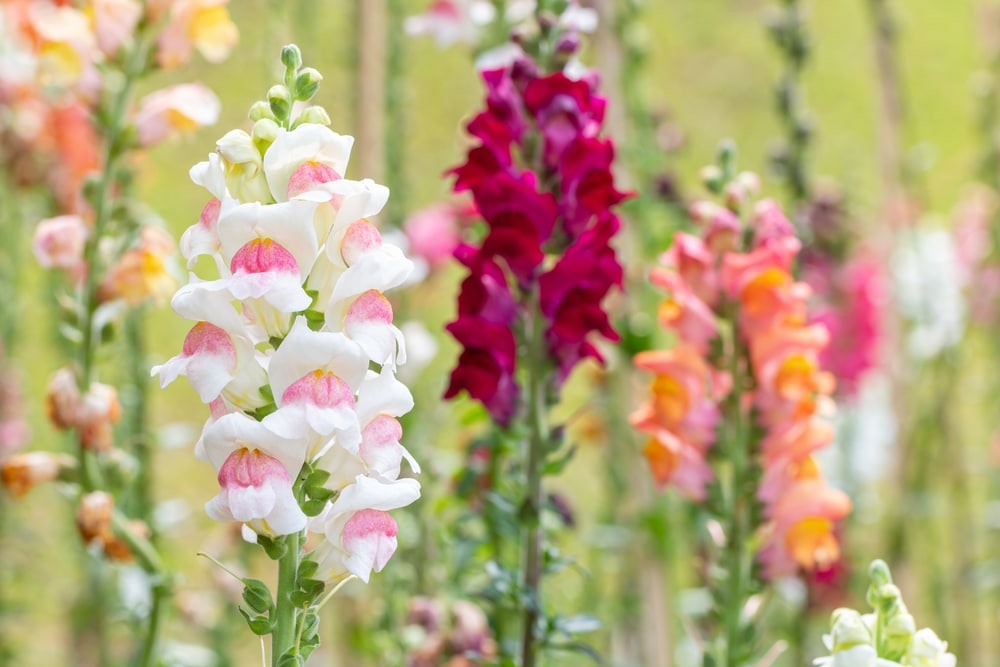
When you squeeze the snapdragon flowers from the side, it looks like a dragon’s mouth is opening and closing (hence the name). Snapdragons aren’t just an interesting sight to behold, though. They’re also ideal for a pollen plant garden.
They’re perfect as a background plant in the flower bed and can grow up to three feet tall. They bloom in early spring and continue flowering until around October.
Place your snapdragons in well-drained soil in full sun to get the best out of them. They’re tolerant of frost and need at least one inch of water weekly.
13 – Chives
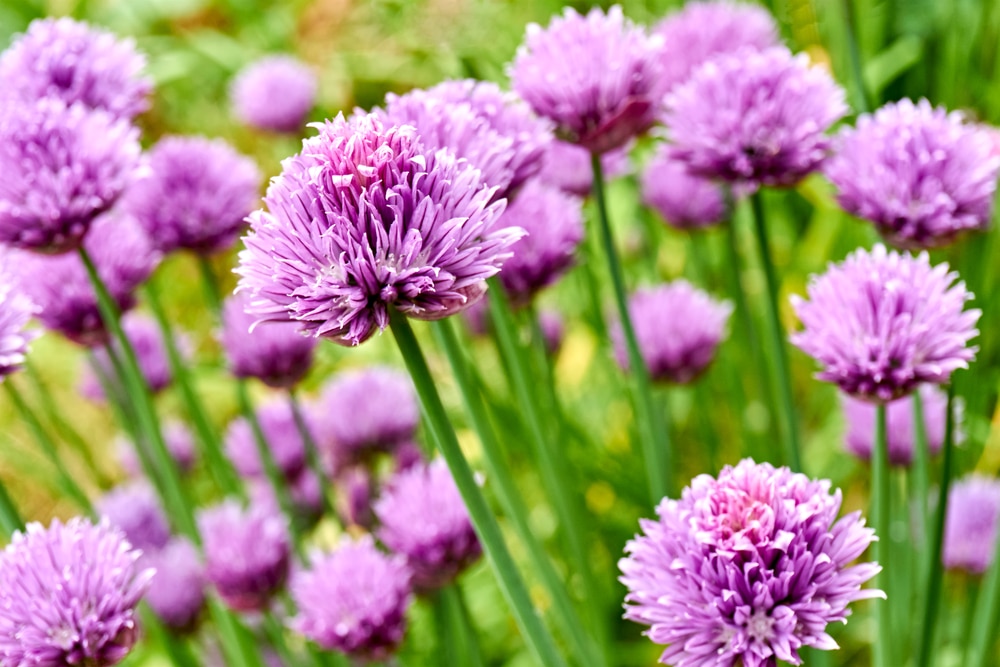
Chives are brilliant to grow in a kitchen garden as the leaves and flowers are edible. This plant produces delicate light purple flowers in the spring and summer, which are also perfect for pollinators.
Caring for chives is incredibly easy, and they’re ideal for any garden since you can grow them in pots or in the ground. However, make sure they have a sunny or partially shaded spot.
It’s best to plant chives around four to six weeks after the last frost. They’ll need water around once or twice a week. Be sure to allow the soil to dry around the plant before adding more moisture, and use well-draining soil.
Regular harvesting of chives will encourage better growth and a greater yield in the future.
14 – Mustard
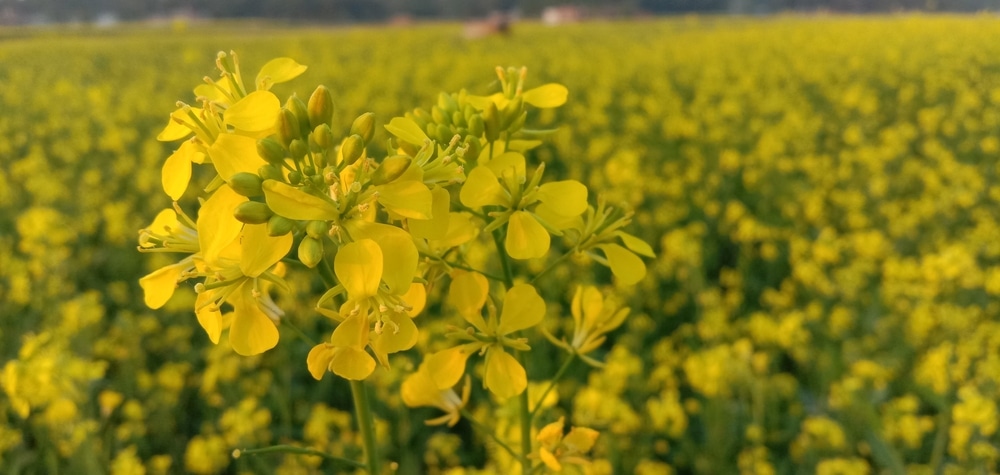
Mustard is a pretty impressive plant in that it can grow up to 30 feet tall and 20 feet wide, so it’s a good choice for large gardens. It grows well alongside mint and chamomile and will produce pretty yellow flowers bees love!
The great thing about this plant is it’s straightforward to grow and will produce edible seeds in as little as two months. Plant it in May for blooms in the late summer and early fall, but make sure you place the plant in a partially shaded or full-sun location.
Mustard plants require a lot of water, so it’s important not to let the soil dry out. However, soak the soil to about an inch below the surface, as light watering won’t encourage the roots to grow deep, making the plant vulnerable to drought.
15 – Snowdrop
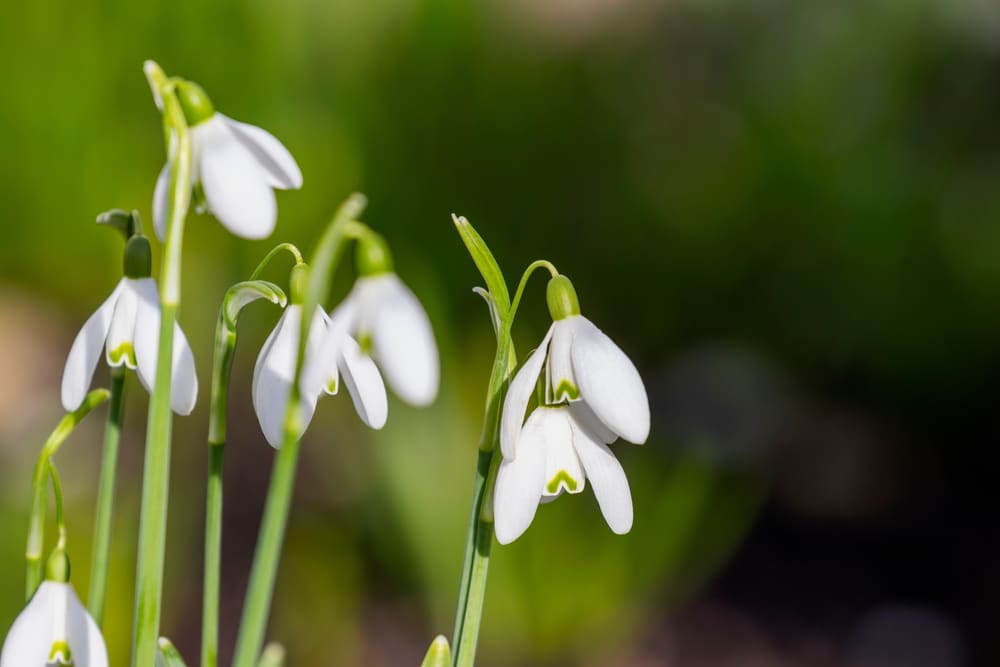
Snowdrops produce incredibly diverse and pretty white flowers. You can plant them in a shady spot in the ground or, if you’re looking for a balcony plant, simply pop them into a terracotta pot.
You can plant up to 25 snowdrop bulbs together for a beautiful display, but ensure they have at least two to three inches between them. Water them well, as even once rooted, these plants do not tolerate arid soil.
You should plant snowdrop bulbs in the fall and be ready for them to flower as early as January, making them one of the first bloomers in your garden. You won’t need to prune the plants, but deadheading them is a good idea as this will encourage greater blooms the following year.
16 – Crocus

Depending on the crocus species you choose, you’ll be treated to purple, white, orange, or yellow flowers. These are low-growing plants, and their stems never come above the ground. Even so, the flowers are a surprising size, and they’re perfect pollinator plants thanks to their early spring blooming period.
Growing crocuses does require a little more maintenance than some other plants. Even though they’re early bloomers, you may need to cover them if the weather is still severe. Moreover, while it is a good idea to heavily cover the soil around the plant with mulch in winter, you’ll need to remove this in spring.
There’s no need to deadhead these plants. Depending on the variety, the plant may require full sun or partial shade.
17 – White And Yellow Sweet Clover
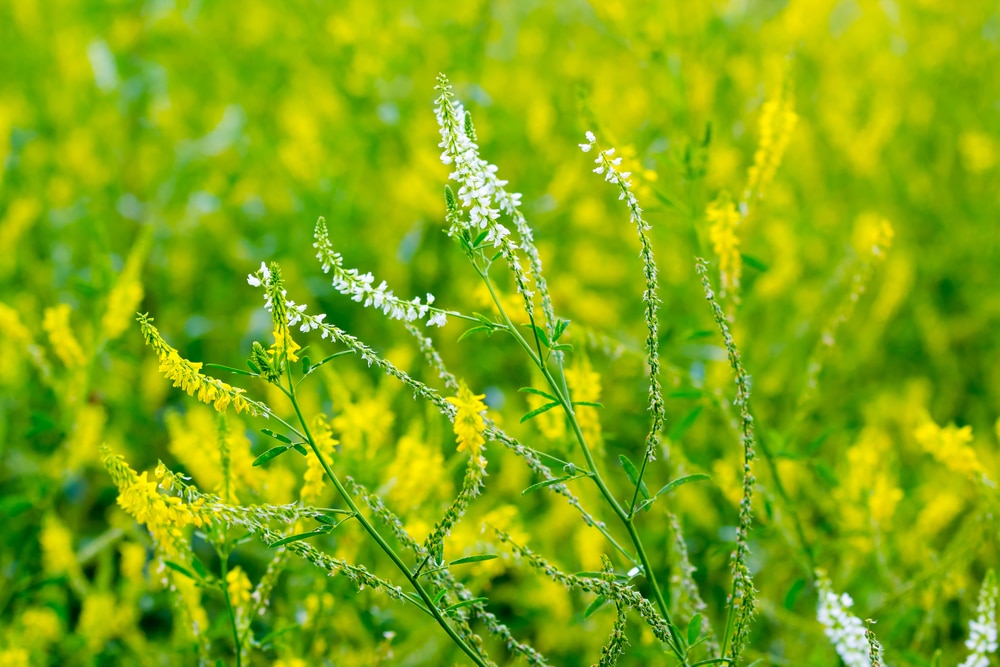
Producing white or yellow dainty flowers along a slender stem, sweet clover is perfect for all gardens. It’ll grow well in all soil types (apart from very acidic ones) and is ideal for attracting bees.
Well-established plants are very robust; once the roots are deeply set, they’ll handle drought with few problems. Many people see this plant as a weed, but it’s wonderful for adding a wild character to a pollinator-friendly garden.
You will need a lot of space as these plants can grow up to four feet tall. Keep in mind this plant only flowers every two years.
18/19 – Blackberries And Raspberries
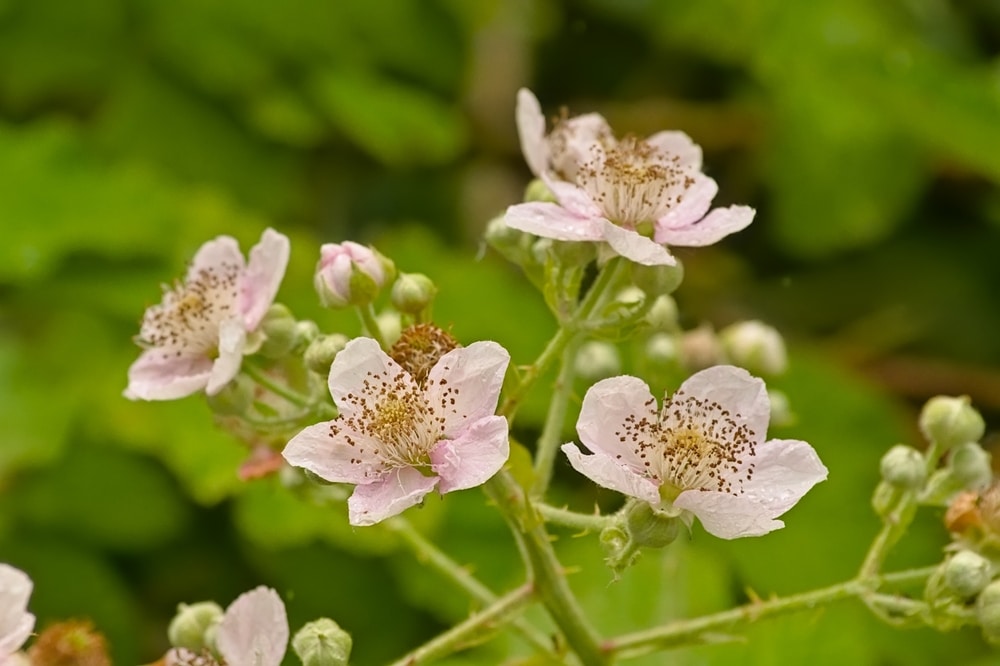
Grow raspberries and blackberries separately as they’re not ideal companion plants (plants that grow well together). However, it’s still possible to grow them in the same garden, plus they yield lots of sweet fruit.
Plant them in the spring. However, you’ll need to space the plants well apart and give them a trellis for support. The plants will struggle to hold themselves up once the plants grow.
Water your plants well for the best harvest with the juiciest fruits. Giving them up to two inches of water a week is not unreasonable. You can expect the plants to bloom in late spring/early summer and attract pollinators like honey and solitary bees (bees that live independently and not in colonies).
20 – Blueberry
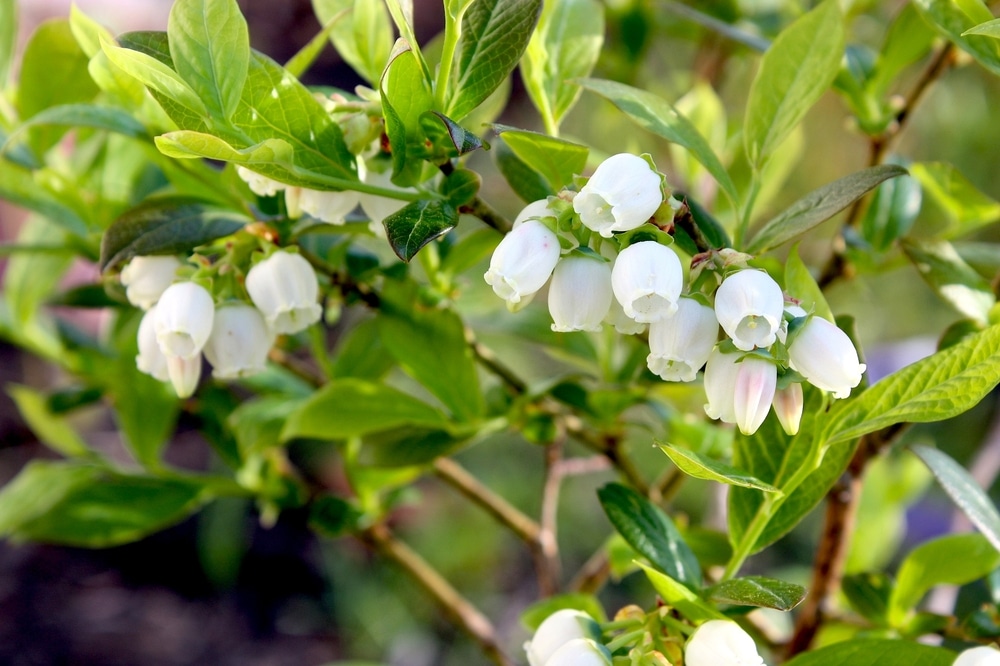
During spring, the blueberry plant produces beautiful bell-shaped white flowers that attract wild bees. Many species, including bluecrop, can self-pollinate, but cross-pollination (when the pollen transfers from one plant to another) increases fruit yield in mid-summer
The most important thing is to keep your blueberry plants moist. Regular watering is essential, and not letting the soil dry out is vital. I recommend around an inch of water each week. Of course, avoid overwatering, as this can cause damage to the roots.
Potting blueberries is also possible if you don’t have much space. That said, these delicate plants do need additional care and careful watering when kept in containers.
For example, the soil may dry out more quickly in containers, so you may need to increase your watering frequency. This may mean offering as many as two inches of water each week. The soil should also have a pH between 4.0 and 4.8 for the plants to properly absorb nutrients.
Finally, when keeping blueberry plants in pots, you should know how much sun they’re getting. Typically, they need between six and eight hours, but the plants may wilt in the hot afternoon sun. This means assessing your garden before introducing the plant and choosing a spot that offers just the right amount of light.
21 – Marigold
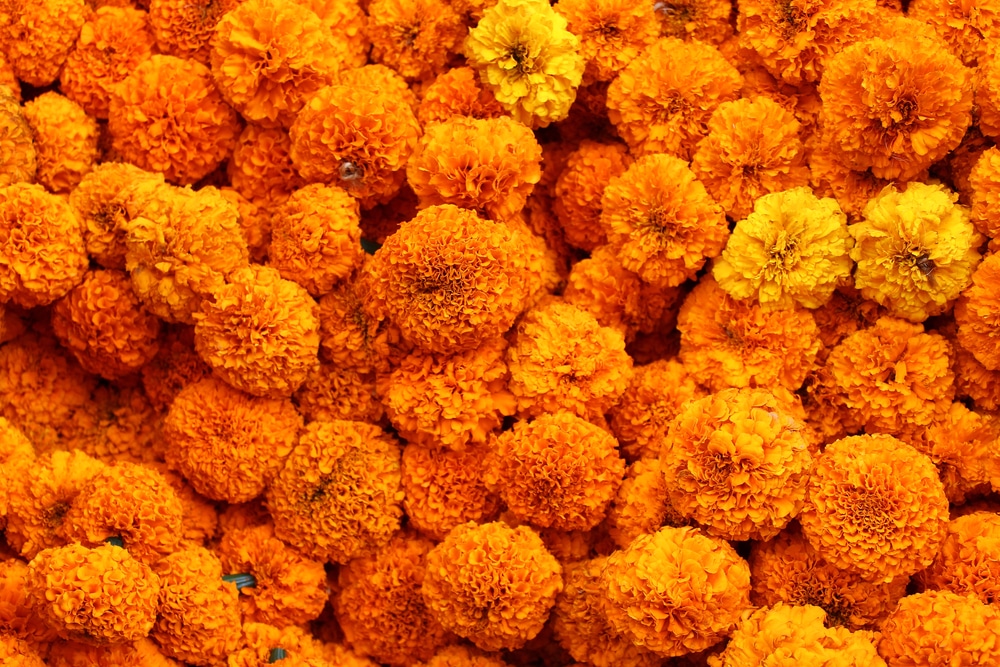
Marigolds are one of the most common plants gardeners use to attract bees and other pollinators. Not only are they super effective for this, but their beautiful golden-orange hue is a welcome addition to any garden.
Most varieties of marigolds like a position in full sun, and they’re ideal for warmer climates as they tolerate high temperatures well. While they require moist soil in the first few weeks after planting, once established, you’ll only need to do this once a week.
Expect beautiful rich-colored blooms for a good part of the year since marigolds flower from spring until fall!
22 – Heather
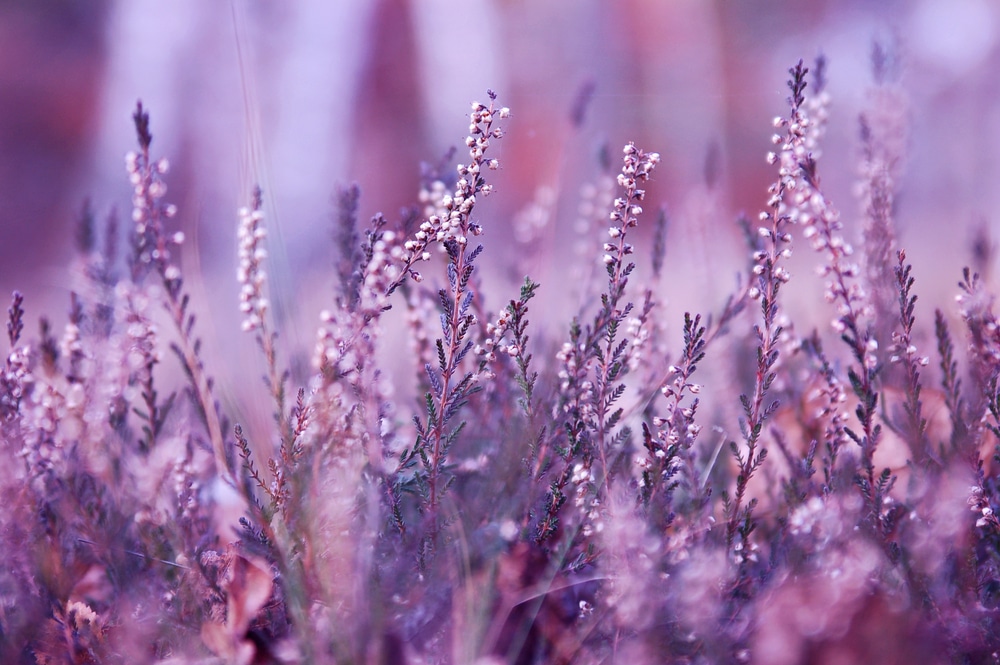
Heather is native to Europe and Asia and boasts pretty purple blooms from late summer all the way through to fall. These plants are great if you’ve got some open ground to fill, but you can also put them in containers.
Choose a sunny spot, as this will encourage more vibrant blooms. Otherwise, this is a beginner-friendly plant as it requires little maintenance.
Heather is extremely drought-tolerant and only requires watering between every two and three weeks. As long as there’s a little moisture in the soil, they’ll grow well.
23 – Thistle (Including Blue And Star Thistle)
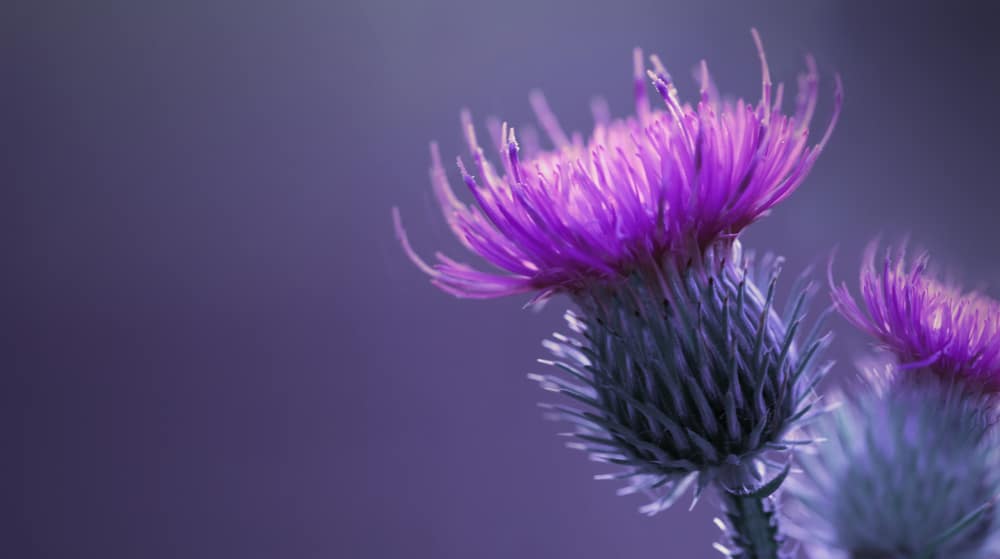
If you want to grow thistle, you’ll need to choose a sunny spot in well-draining soil. You’ll get pink blooms attracting beetles, bumble bees, and moths. What’s great is these plants are extremely tough and will tolerate poor soil well.
This could include sandy or rocky soils as they do not contain many nutrients, and it’s difficult for most plant roots to absorb what little nutrients there are.
However, when grown in the ground, thistle can quickly get out of control. But you can prevent this by growing it in containers. This is also great news for people looking for a patio or balcony plant.
You’ll need to water the plant weekly with between one and two inches of water until it’s established, but then it only needs a top-up when it shows signs of drought. Plant it next to other drought-tolerant species like lavender for the best results.
24 – Cucumber

There’s nothing more refreshing than a slice of cucumber in a glass of gin or mixed with leaves to make a tasty salad. Growing your own is a wonderful way to be sustainable and self-sufficient. The good news is these are relatively simple plants to grow.
You can grow them from seeds indoors or buy a small plant and find a spot offering shade. While cucumbers like a bit of sun, they are prone to scorching. This also means you’ll need a strict watering schedule of at least one inch per week.
These plants will produce small yellow flowers around 40 days after you plant them. You’ll then be rewarded with tasty fruits around September. Keep in mind the more fruits you pick, the more the plant will produce.
25 – Melons

Another brilliant edible plant is the melon plant. These sweet fruits are ideal as a dessert; each plant will produce around six per season. However, I wouldn’t suggest this plant for beginners as it’s not the easiest to grow.
You’ll almost certainly need a polytunnel (tunnel greenhouse) in cooler climates, but in warmer climates, you can plant outdoors in a sunny, sheltered spot. You can also try covering the soil with some black plastic, as higher temperatures mean a better yield.
Provided the plant has had between eight and ten weeks of optimal growing conditions, it’ll start to flower between June and August. Honey bees are among some of the most important pollinators for melons, and farmers even have their own colonies to ensure effective pollination.
26 – Pumpkins
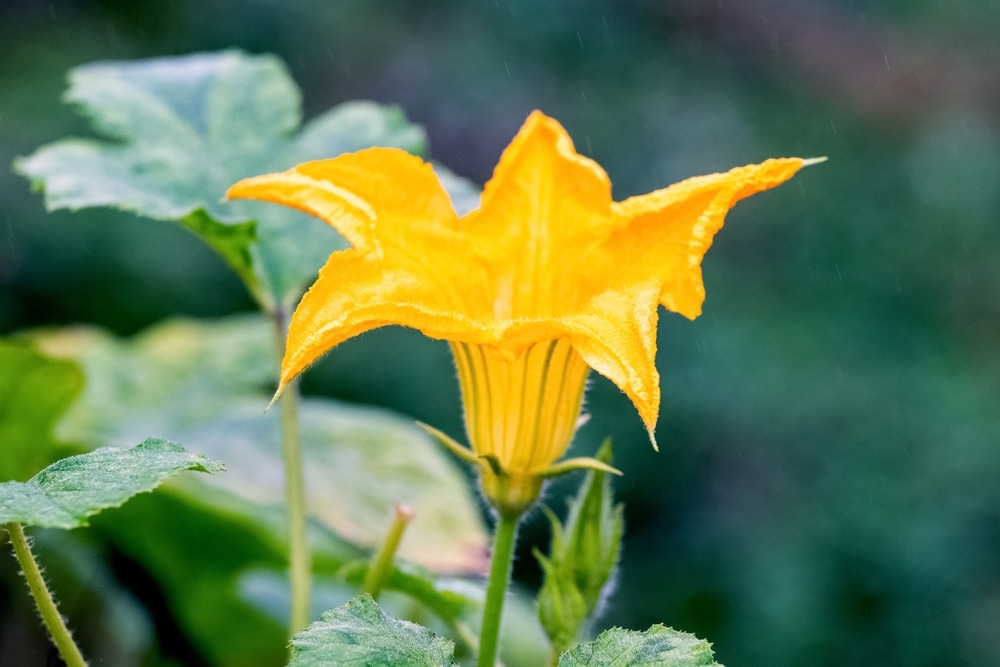
For anyone that has kids, pumpkins are a fun plant to grow and harvest at Halloween! What I really love about them is they’re so easy to grow. They’ll thrive as long as they have a warm, sunny spot and shelter from the wind and will do best when planted between April and June.
These plants typically bloom in mid-July. Pumpkins produce male and female flowers; you’ll notice the male ones popping up first. Female flowers have a tiny pumpkin at the base, but removing the first few is often recommended to encourage stronger flowers to come through.
I grew some pumpkins with my kids last year, and while they weren’t the largest fruits, they were more than enough. If I were to grow them again, I wouldn’t make the mistake of watering them as often.
I watered every couple of days, but after researching, I discovered that giving more than an inch a week causes the roots not to set as deeply. This means the plant doesn’t get as many nutrients.
Regarding space, the type of pumpkins you’re planting will have an impact. Trailing varieties must be spaced at five-foot intervals, whereas bush varieties may only need around three feet of space.
27 – Lupine
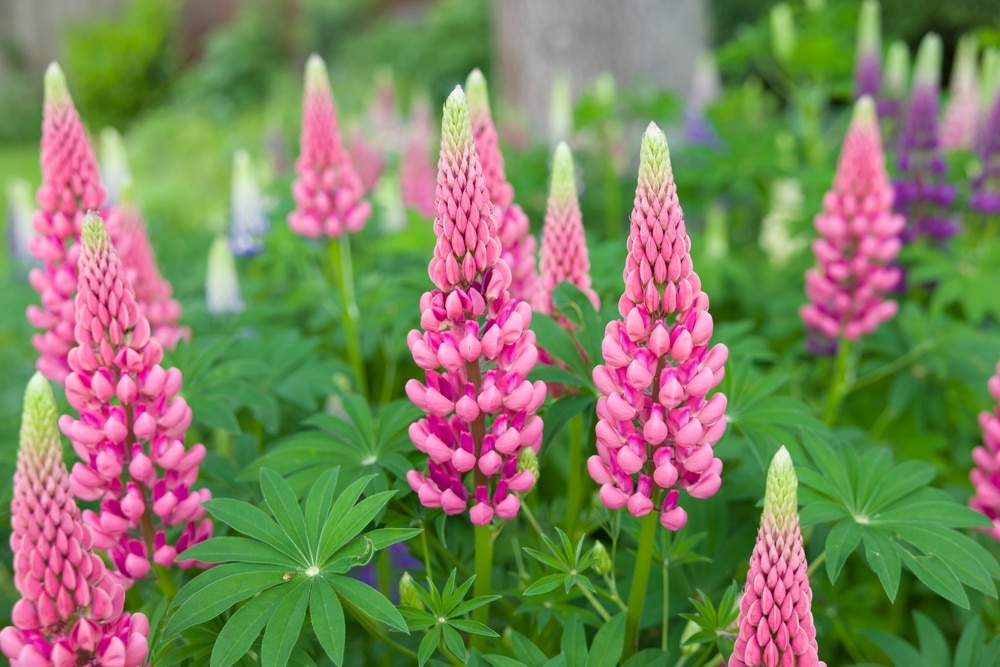
Lupine flowers are the perfect plant to fill a border with color. Most varieties are perennials, but there are a few annuals, so double-check this if you want a plant that lasts more than one year.
Generally, lupine flowers are easy to grow because they have long taproots (large roots other roots grow from) to take water and nutrients from deep within the soil. However, growing them from seed can be a little tricky as they’ll rot if the soil gets too damp.
I’d recommend watering the plant well initially and then providing an inch of water each week until it is fully established. After this, thanks to those long roots I mentioned, you’ll rarely need to water lupine. However, in periods of severe drought, you can use a drip irrigation system to avoid overwatering.
Coming in various colors from purple to white, lupine flowers typically flower in May. As long as you deadhead them regularly, these blooms will last until the end of August.
28 – Buckwheat
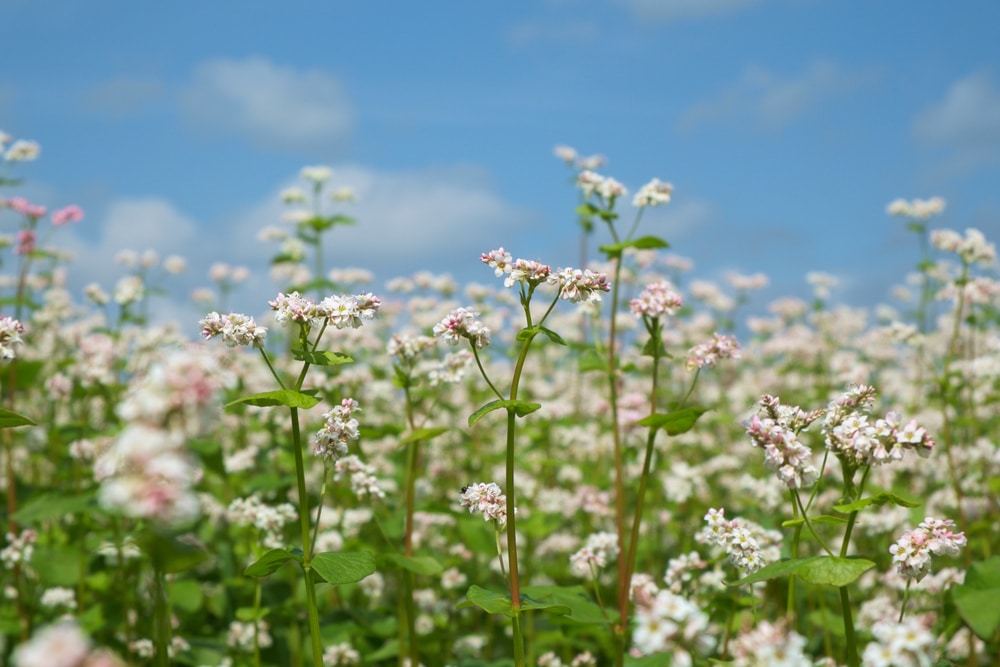
If you’re like me and have a garden with poor soil, then buckwheat is an excellent choice. It’s a tough plant that can thrive in all soil types, even those without many nutrients. However, I do find that adding mulch to the soil benefits the plant.
Buckwheat produces flowers between June and September and is a great companion for mustard. Combining these two will give fantastic ground cover if you have a bare spot that needs filling.
While the flowers are small, they’re incredibly nectar-rich, so they will attract a whole host of insect pollinators. You’ll need to plant in a position with full sun, but be mindful that high temperatures can cause the plant to wilt, which prevents it from flowering.
29 – Bluevine

Bluevine (also known as honeyvine, sandvine, and climbing milkweed) is ideal if you live in a tropical area, and I think it’s the perfect addition to a garden that needs a pop of color. The flowers boast a deep blue hue and will bloom between the start of summer and early winter.
While growing in a cooler climate is possible, I recommend native plants. However, this one will still produce blooms in mid-summer.
Attracting bees and butterflies, bluevine is a brilliant option for trellis, pergolas, or fences. Many people cut the plant to use the flowers for indoor arrangements.
Make sure you offer your bluevine in full sun. These plants like well-drained soil but will tolerate all pH levels.
30 – Basil
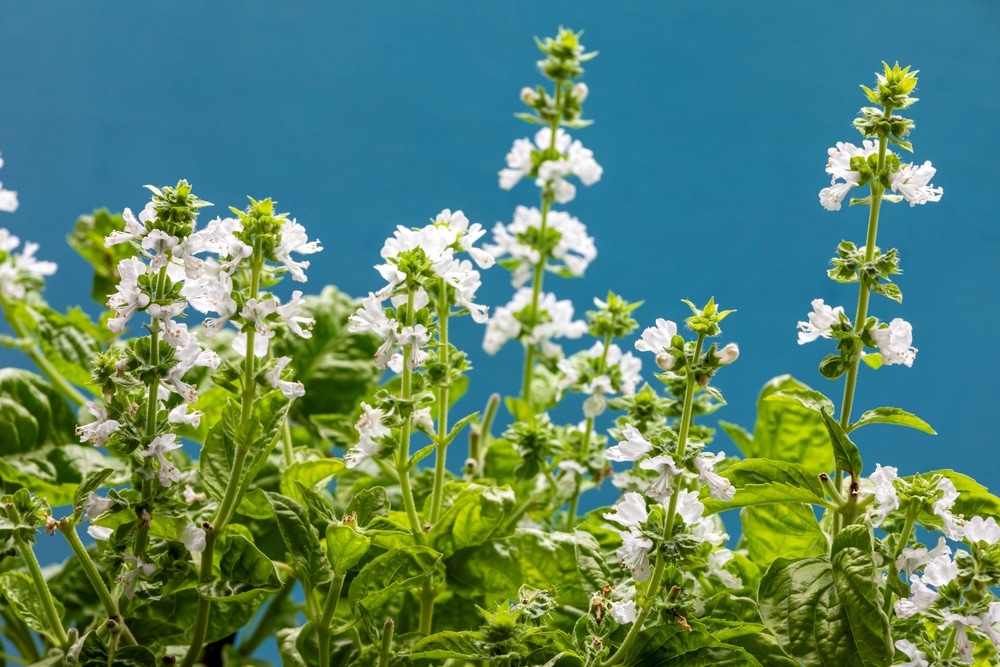
Growing a kitchen garden? Basil is one of the top plants to include. It has a beautiful fragrance, is ideal for garnishing food, and boasts pretty, delicate white flowers at the tops of the stems.
Bees love basil, too, so it’s perfect for a pollinator garden but requires some tender care. For example, overwatering, especially if it gets on the leaves, can cause mold. But they still need around one inch of water each week. Moreover, basil needs to be sheltered from wind and frost.
The good news is these plants are perfect for growing in pots and can be kept indoors in a sunny position.
31 – Poppy
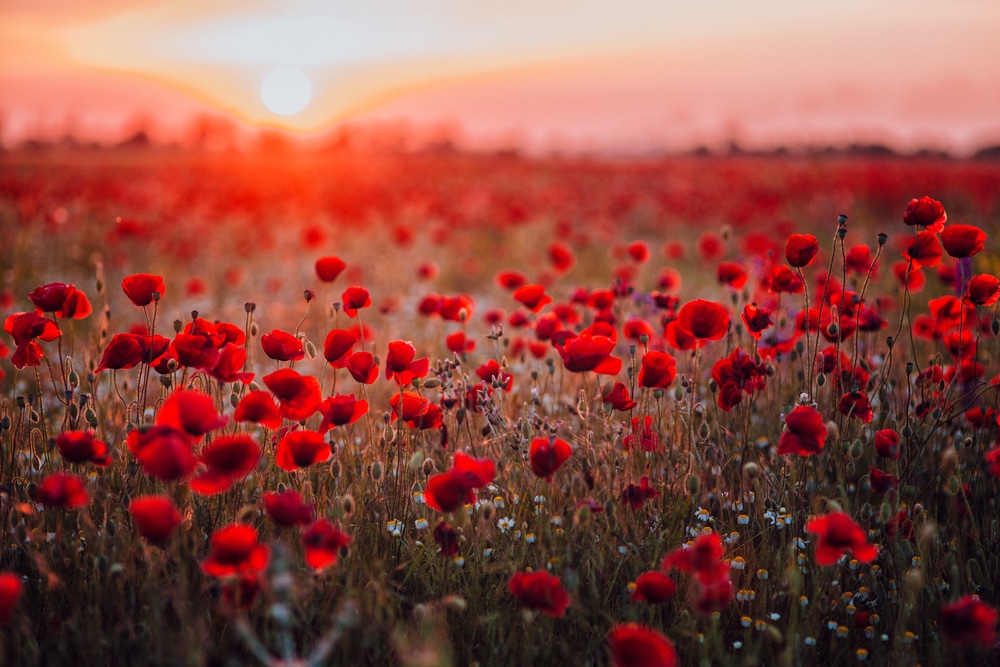
What I love most about poppies is that they’ll work well in any garden, as they’re tolerant of sunny and shady spots. Moreover, they aren’t fussy about soil type, so they’re one of my favorite plants to grow.
I have a partially shaded bed at the top of my garden where not much else thrives, but poppies and bluebells always do well.
I like to water them between every seven and ten days and usually give up to an inch. Overwatering can cause the roots not to set as deep, which is detrimental to the plant’s survival.
If you sow your poppy seeds in the fall, you’ll be rewarded with more abundant blooms between June and September the following year.
32 – Mallow And Common Mallow
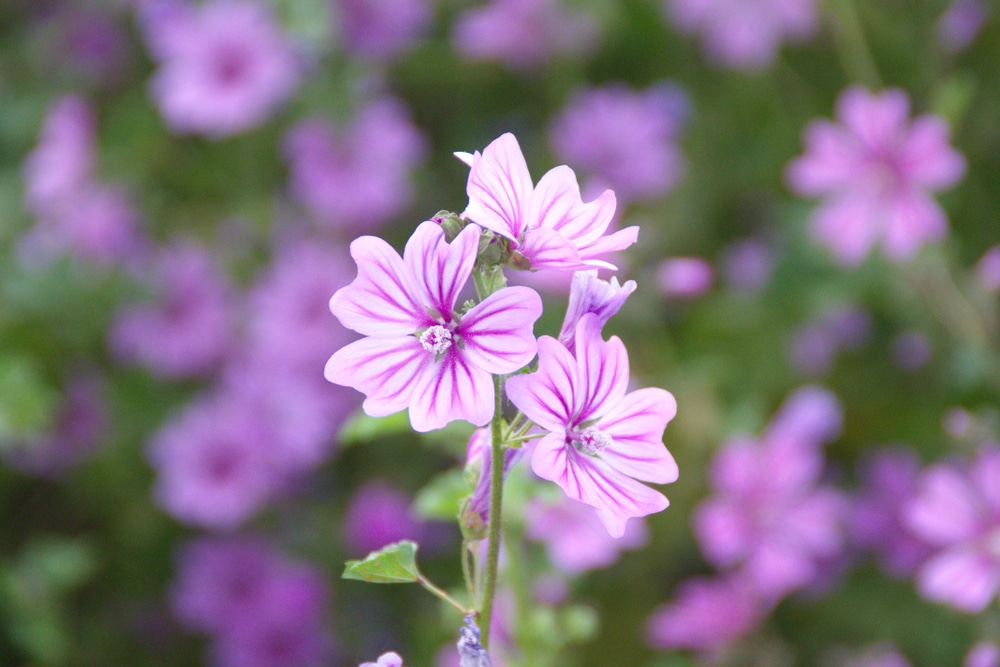
Mallow is a great choice when you’re just starting as a gardener and want to introduce pollen plants. These plants can easily grow from seed with full sun and well-drained soil. One thing you should note, however, is they require incredibly nutrient-rich soil.
Other than that, mallow is easy to care for. Water deeply every one to two weeks; I’d recommend soaking the soil down to a depth of six inches during the first year. In June, you’ll start to notice pretty lilac-colored blooms.
I personally like this plant as a border for walkways, and it’s also great in a garden box (raised garden bed). While you don’t really need to prune this plant, you can trim it to keep the spread under control.
33 – Cat Tail
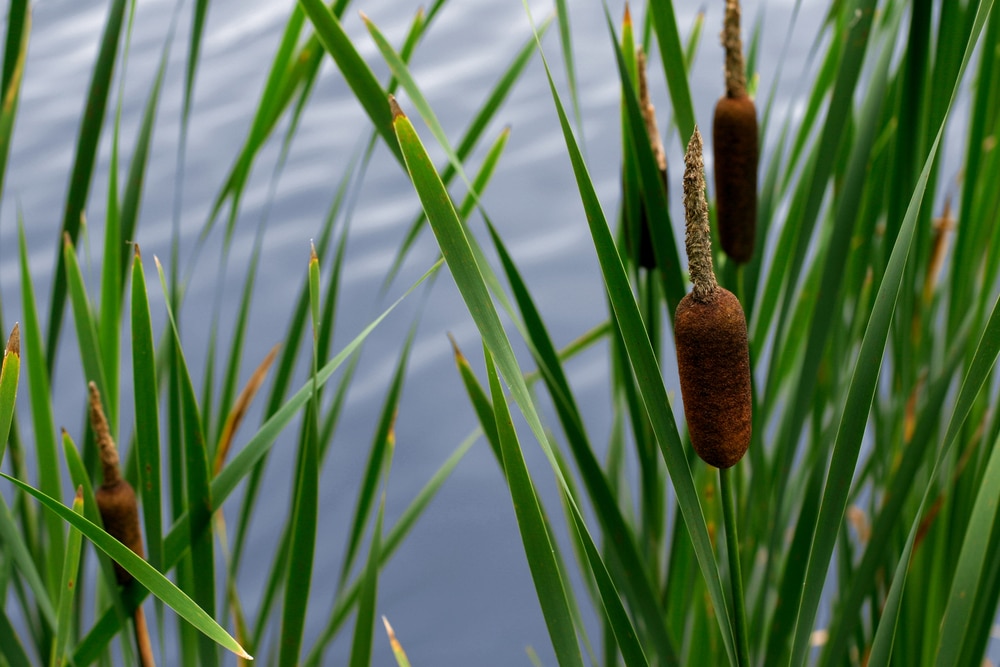
Male and female cat tails produce brown flowers that typically open from late spring to mid-summer. They’re ideal if you want something that looks a little less traditional and more wild.
I highly recommend these plants for areas with very wet soil. They’ll grow in up to one foot of water. They make an excellent addition to the edges if you have a pond or other water feature.
Cat tails are self-pollinating plants, so they won’t attract pollinators. However, they are a food source for other wildlife like waterfowl and frogs.
34 – Sweetcorn
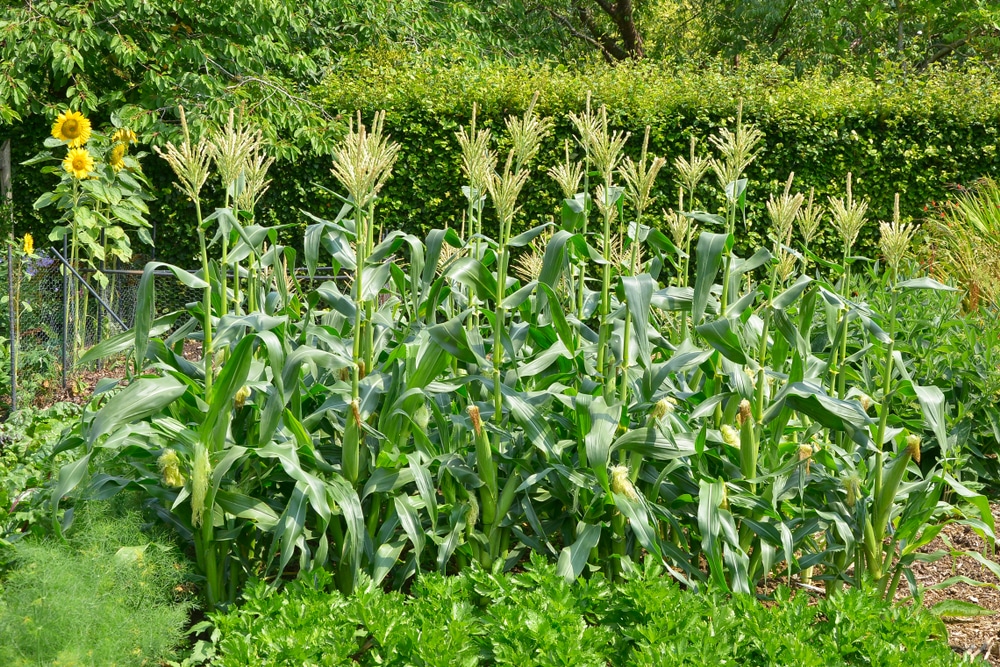
Sweetcorn is a tasty edible plant, and it’s pretty simple to grow. It will need frequent watering (around one inch weekly) until the plant is established. Still, after that, it’ll typically look after itself. You may need to do additional watering in periods of drought.
Choosing a sunny yet sheltered spot for sweetcorn with nutrient-rich soil is essential. While it will grow in heavy soil, the chances of large, healthy cobs will decrease.
Sweetcorn usually flowers in spring but primarily relies on wind pollination. Because of this, plant in rows for the greatest success. That said, you’ll need to ensure each plant has enough space, so plant between 14 and 18 inches apart.
35 – Ivy
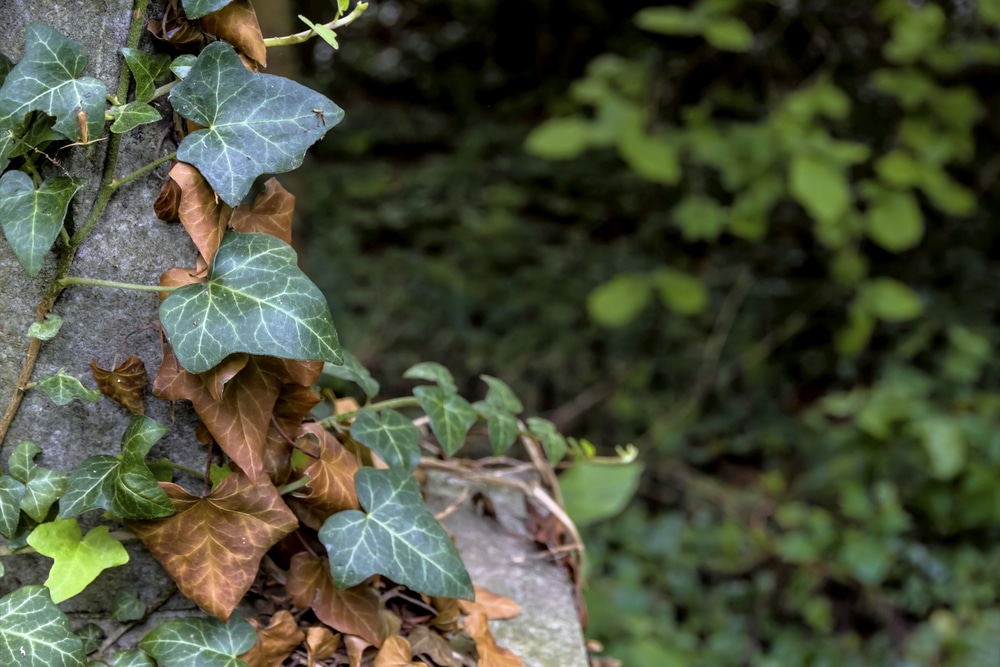
A climbing plant, ivy is ideal for fences or trellises. I like to use ivy to make a natural-looking privacy screen. However, it’s vital to remember that this plant can quickly grow out of control. For this reason, it’s best to grow the plant in a container and allow it to climb.
While ivy does like a sunny spot, this plant is well-known for being tolerant to completely shaded positions. The plant offers year-round greenery but will flower between September and November; perfect if you want a pop of color after many other plants have faded.
When watering, only do so when the top inch of soil has dried out. Moreover, you’ll need to decrease water during fall and colder weather. This plant also grows best in well-draining soil in containers with drainage holes.
36 – Goldenrod
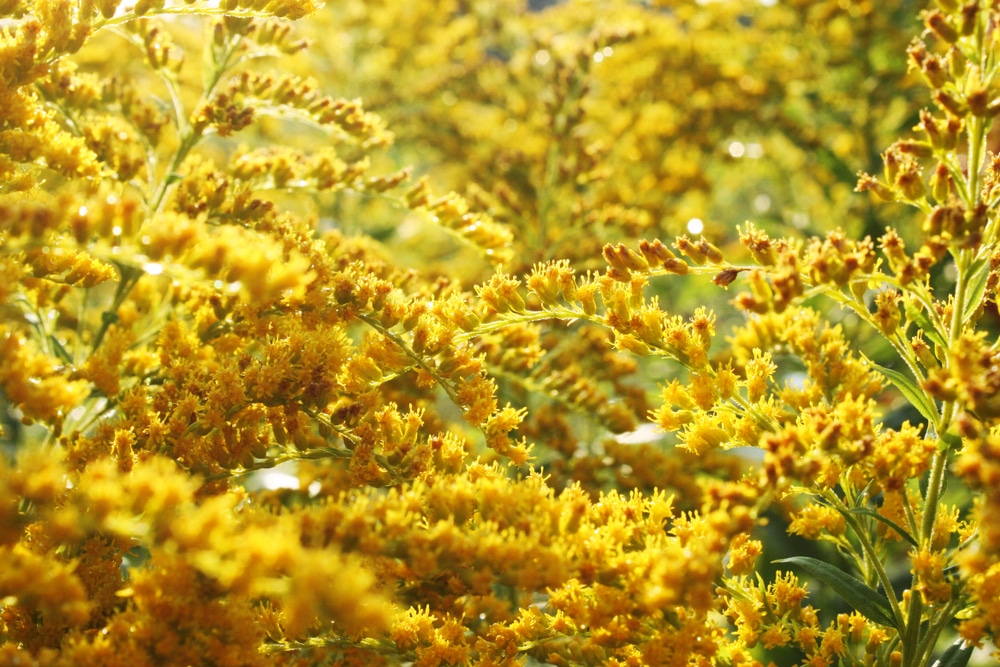
One of the best beginner pollen plants is goldenrod. Once established, these plants take most of their moisture requirements from rainwater. While they are drought-tolerant, I would recommend providing extra water when it’s very dry.
Goldenrod produces clusters of bright yellow flowers from late summer all the way through to fall. There are even some varieties, such as fireworks, that continue to bloom until the first frost.
Goldenrod is a top choice for attracting pollinators. Bees, butterflies, moths, beetles, and beneficial wasps all love this species.
Pollen-Rich Trees To Grow In Your Garden And Tips On Caring For Them
Trees are a fantastic way to fill space and create a focal point for larger gardens. That said, you can put some smaller species in pots to make beautiful patio plants.
Let’s start with maple trees.
37 – Maple (Including Manitoba, Norway, and Red Maple)

With a great variety of maple trees to choose from, there’s truly something for everyone. If you’re looking for a tree that’ll create shade, maple is ideal, although it prefers a sunny spot.
Depending on the variety, maple saplings may take between 15 and 30 years to fully grow. Again, the species type will depend on when the tree flowers, but some varieties, such as red maple, may flower as early as four years old.
Blooms start to appear around April and will attract pollen-loving insects. However, most species, including the sugar maple, are self-pollinating.
38 – Chestnut (Including American And Sweet Chestnut)
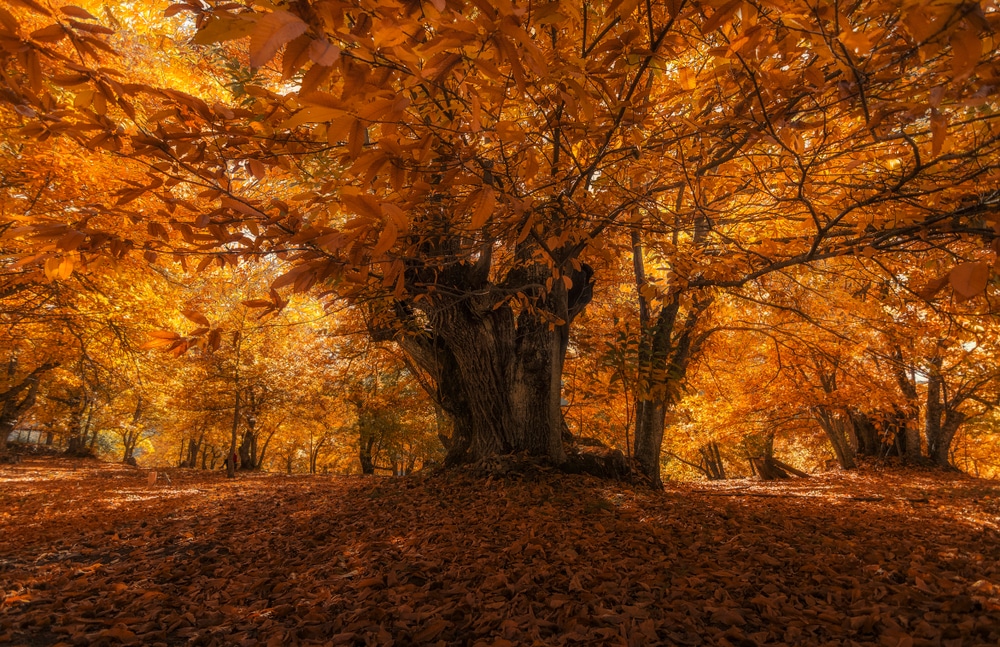
Chestnut trees require very little from you if you want to grow them. However, most people want to harvest the chestnuts, which means more care on your part.
Plant chestnut saplings in a sunny spot in late fall or early spring. They require deep, well-drained soil with lots of nutrients. When the conditions are good, the tree will flower around the middle of May and produce clusters of mid-red blooms that attract lots of beneficial flies and bees.
39 – Chinese Elm
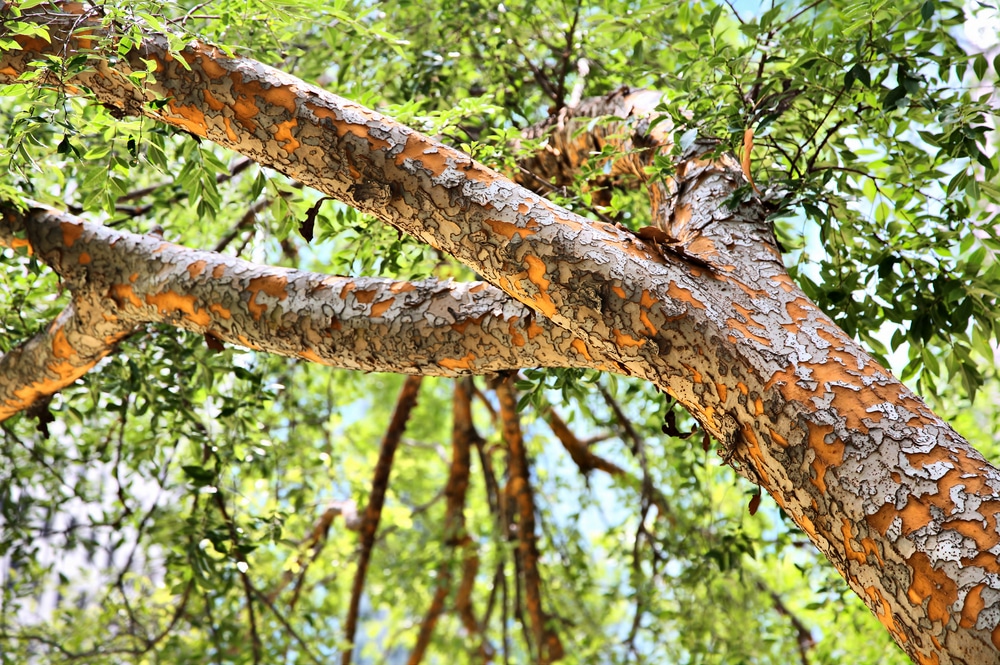
Regardless of your soil type, Chinese elm will do very well as it easily adapts to its conditions. These trees are wind- and heat-tolerant, but make sure they have a sunny spot.
Chinese elm flowers in early fall, but if you’re looking for a tree with bright blooms, it might not suit you. The flowers are very inconspicuous, small, and green.
You’ll need to water saplings between every three and five days. However, once the tree is established, allowing rain to handle watering duties is fine. That said, you may need to offer a little more water in times of drought.
40 – Oak

Male oak tree flowers hang in green clusters, dangling from the tree from around April. The female flowers don’t appear until later and are tiny red flowers among the leaves. Well-established oak trees provide a pollen source and a great habitat and shelter for pollinators.
Of course, these mighty trees take many years to grow, so you’ll need to stay patient. What’s more, they can live for hundreds of years and provide something of a gardener’s legacy.
Dig a hole no bigger than the sapling’s root ball when planting oak. Loosely fill the hole with soil. Choose a more acidic soil and keep in mind these trees prefer partial shade or full sun.
In terms of water, you’ll need to give the sapling a deep watering at least once a week. It might sound like a lot, but in those early days, these trees could need up to 10-15 gallons per week! However, overwatering or heavily wet soil can cause mildew which won’t kill the tree but will weaken it.
41 – Willow (Including White, Oak, Violet, Basket, And Pussy Willow)
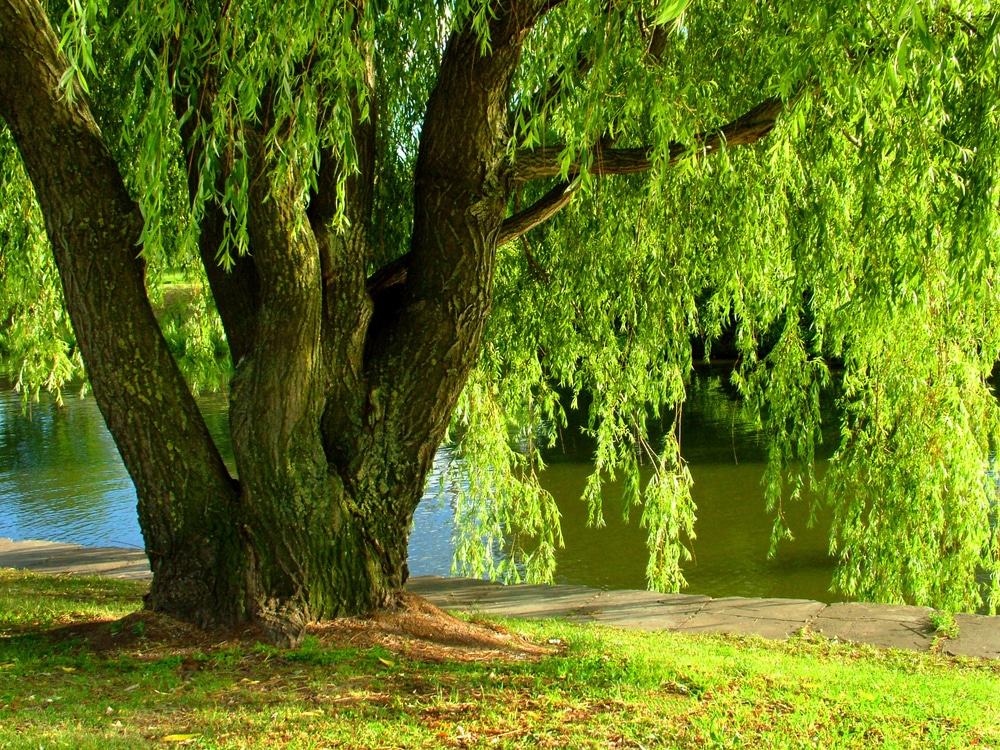
I am a massive fan of bees and want to attract as many species as possible, which is why willow is perfect. Honey bees, mining bees, and mason bees all love this species. Plus, it’s pretty easy to grow and care for.
If you’re looking for a tree that will flower early in the year, then pussy willow is ideal, with its blooms that come through as early as January. However, in colder climates, this might not happen until May.
Willow trees tolerate shade but need between four and six hours of sun a day. If you can find a sunny spot, this is the best option.
With all that said, willow is a heavy pollen producer, so it may not be suitable for hayfever sufferers. Willow pollen is horrible for asthmatics and those who suffer from atopic dermatitis.
42 – American Hazel

It’s possible to grow American hazel even if you have a smaller garden because it’s easy to control the spread of the tree. You will need to find a spot where the tree will get at least four hours of sun a day and where there is well-draining soil.
These trees, that flower between March and April, don’t grow well in water-logged soil. After planting, you’ll only need to offer around an inch of water every ten days. Continue this for the first two seasons. Once established, the rain should provide everything the tree needs in terms of water.
American hazel is not a self-pollinating species and relies on wind pollination. That said, the long green buds that produce pinkish-red flowers provide a pollen and nectar source for bees.
43 – Apple And Crab Apple

If you’re a fruit lover like me, then apple trees are brilliant for the garden. They’ll produce fruit that ripens between August and October, as well as pretty white- or pink-tinged blooms between April and May.
While apple trees can grow quite large in the ground (using free-draining and non-sandy soil), it is possible to control their growth by keeping them in containers. This is fantastic news for those with less space, making this tree ideal as a patio plant.
Bees are responsible for up to 90% of the pollination of apple trees, so if you want to observe these flying insects, this might be the right tree for you.
44 – Flowering Quince
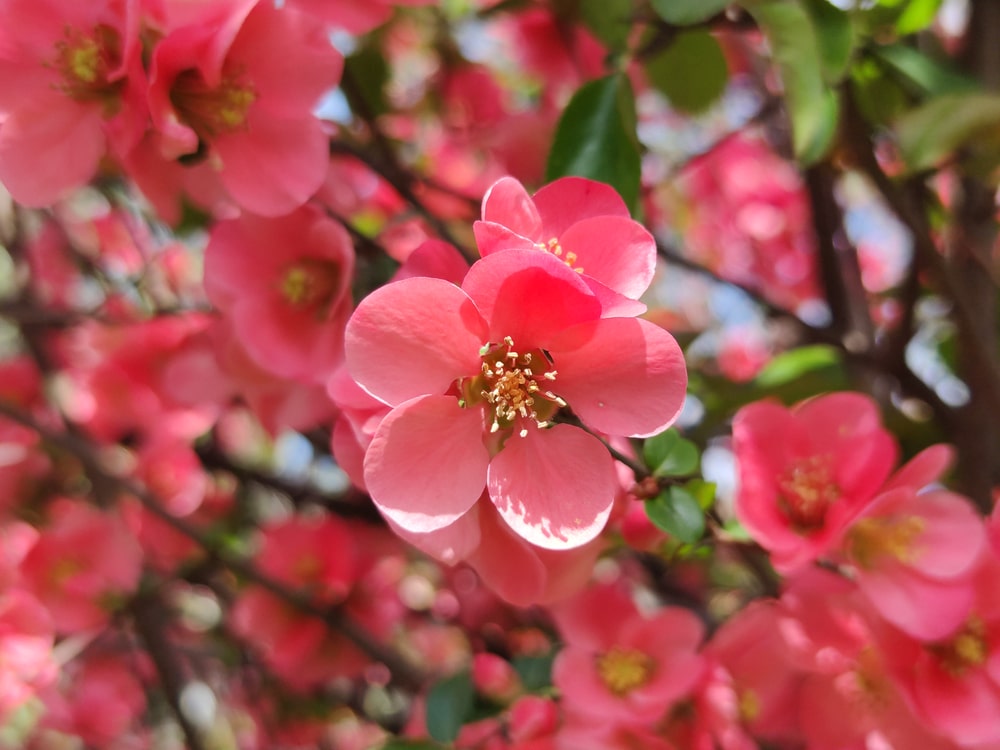
Flowering quince is part of the Rosaceae family and produces tart fruits in the early fall. You can freeze these fruits to soften them and make them into tasty juice.
But not just humans benefit from these trees; pollinators love them thanks to the delicate red to pink flowers that bloom in late winter or early spring.
These trees can have messy growth, so they require regular pruning. However, they will thrive if you plant them in the fall in moist yet well-drained soil. They’re not fussy about soil type but do prefer a sunny location.
Flowering quince needs around an inch of water a week, and they are susceptible to fire blight (a bacterial disease), which can cause the shoots and leaves to wilt and turn gray. While there’s no cure for this, removing infected trees will prevent the spread.
That said, there are things you can do to prevent fire blight, such as avoiding heavy pruning and not using nitrogen fertilizers. What’s more, avoid watering when the tree is in bloom.
45 – Plum Trees
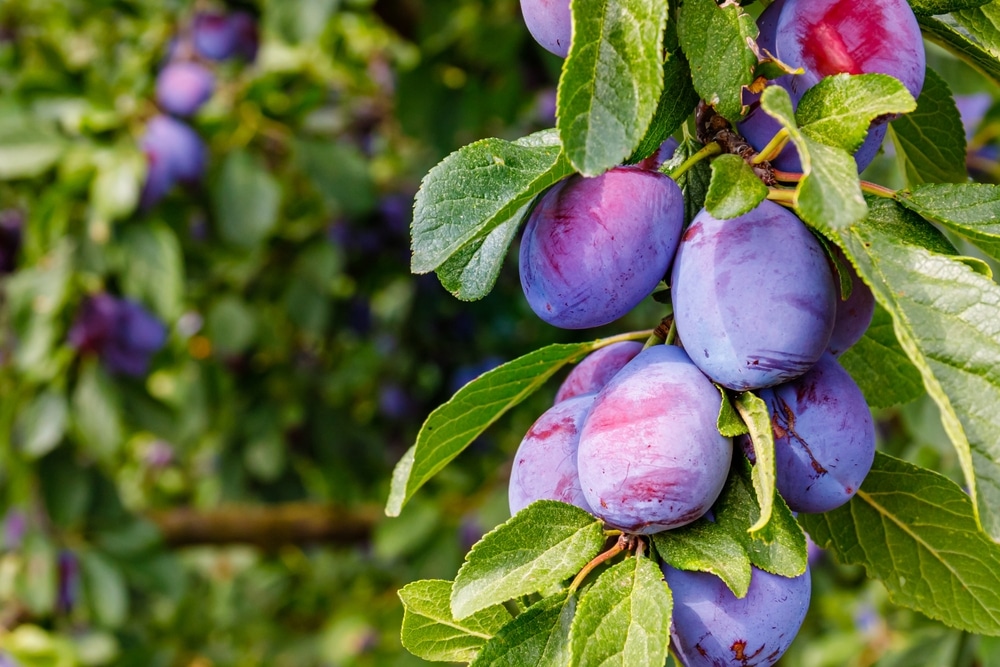
The plum tree is another excellent fruit tree for attracting bees. They produce pretty blossoms during spring, which bring in hoards of our flying friends. Moreover, these trees start producing fruit between the ages of three and six years.
If they’re well looked after, the harvest can be plentiful. My grandmother had a plum tree in her backyard, and she’d send me home weekly with bags full of juicy plums. Trees in sunny but sheltered spots produce the best harvests.
Plum trees are easy to care for and, once established, won’t need watering except in a dry spell. That said, it’s worth remembering that they can struggle during a late frost.
46 – American Sycamore
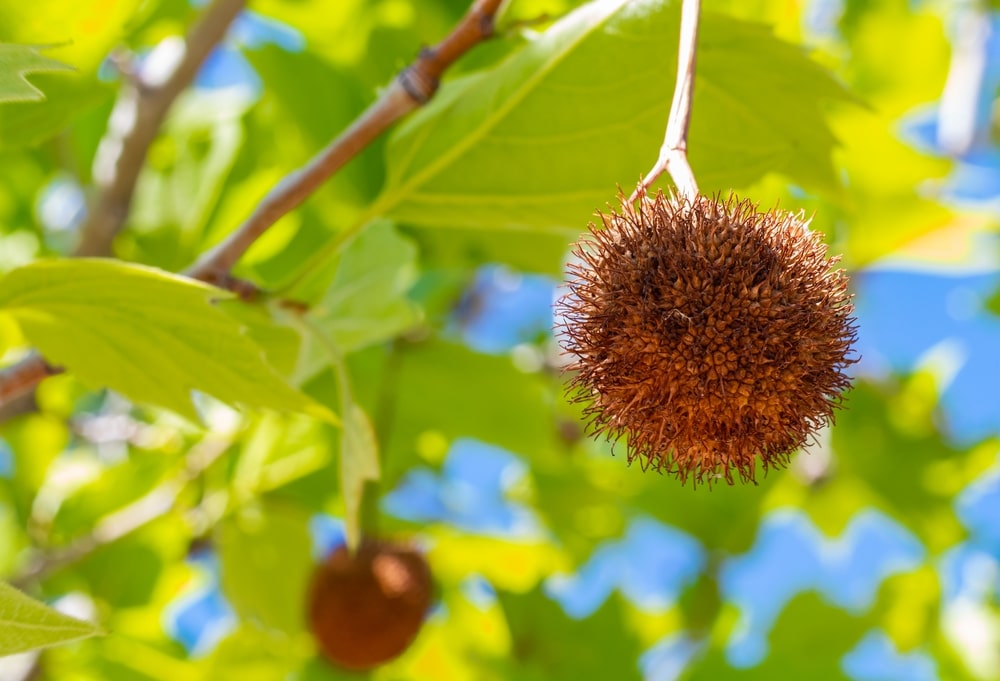
If you’re looking for a less showy tree, then American sycamore could work. However, I should warn you that these trees shed many leaves, so you’ll spend a good deal of time raking.
That said, these trees are otherwise easy to care for and, when established, don’t need much watering. Fertilize the tree every other year (use organic methods like manure or compost) and prune regularly to maintain a good shape.
American sycamore typically flowers around May, but as I mentioned, they’re not particularly showy and appear as small red balls. These then develop into brown fruits and will attract bees.
47 – American Mountain Ash

American mountain ash is a tough species, although it may be susceptible to damage from late frosts or storms. These trees prefer either full sun or part shade, and once they’re established don’t need too much care.
You may need to offer additional water (every 7-10 days so the water penetrates the soil between 24-36 inches) during dry periods in summer. The trees will reward with delicate white flowers between June and July. These flowers will attract bees which pollinate the tree, although wind pollination is also possible.
The American mountain ash tree is resistant to most things but can be prone to a fungal disease called anthracnose, which can cause the leaves to turn brown. This can be due to excess water, but raking away infected leaves can reduce the risk of further infection.
48 – Cherry (Including Wild, Sour, And Black Cherry)

What I love about cherry trees is that some varieties, like Gisela 5, can grow in a large container. However, most varieties are best grown in the ground in slightly acidic, fertile, and well-drained soil.
Most cherry trees require cross-pollination, and honey bees are the primary pollinators for this species. Depending on the climate, the trees will blossom with gorgeous pink flowers between March and May.
Fruits appear between the ages of three and five years at the start of summer, and are all edible. That said, some varieties can be quite tart such as dwarf or sour cherry.
Also, remember not to eat cherry pits as these are toxic (they contain cyanide).
49 – Peach
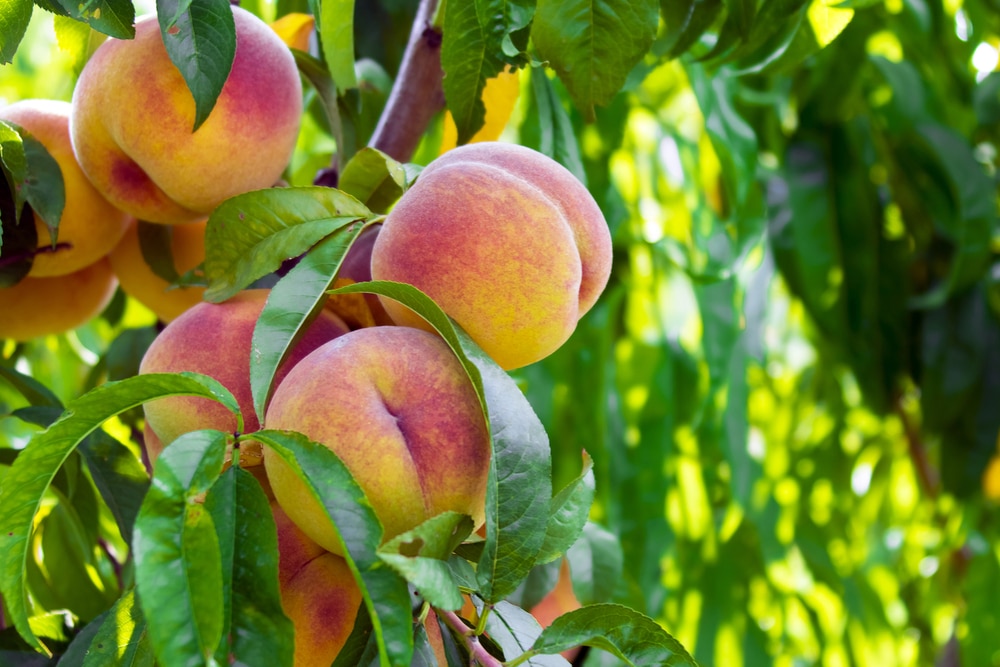
I absolutely love a juicy peach, and growing your own is quite easy. While peach trees will do best in light, loamy, well-drained soil in the ground, it is possible to grow them in pots. I’d recommend a pot at least 18 inches in diameter, and you’ll need to feed and water the tree well.
In terms of water, rainfall will do a lot of the work, but it is best to provide extra water during warm weather in spring and summer. The fruits will be most healthy and abundant when you place the tree in a warm, sunny spot with shelter from the wind.
Peach trees are self-pollinating, but the springtime blooms will attract pollinators as a food source. When pollinators are scarce, it can be helpful to self-pollinate the trees.
50 – Pear
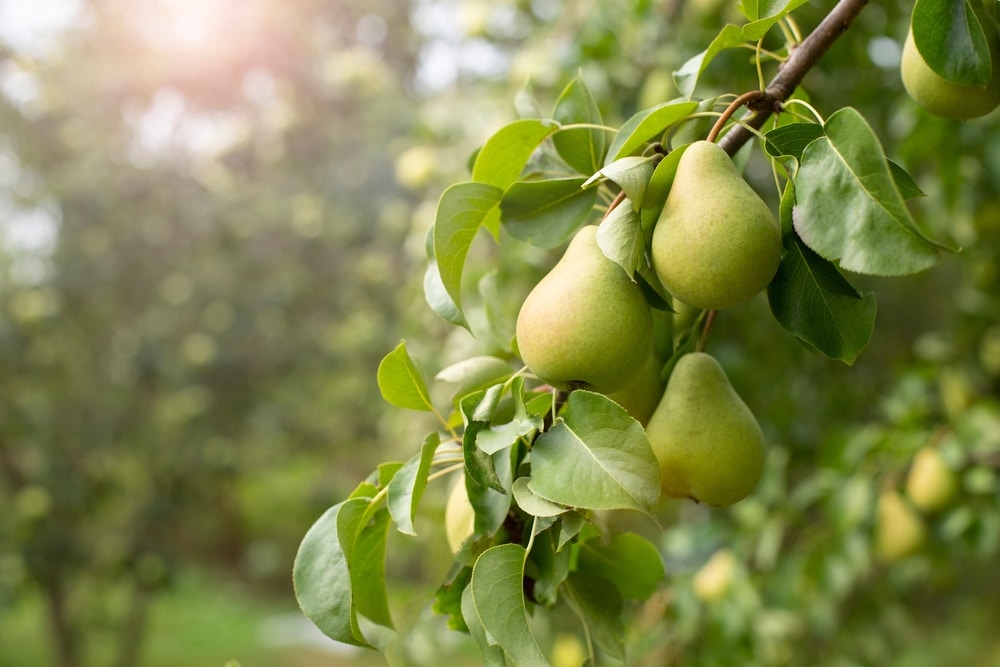
There isn’t always space in the garden for lots of trees, but pear tree varieties like Quince Eline or Quince C are dwarf species that you can grow in containers. These make a lovely addition to a patio but do require full sun. They may grow in partial shade as well.
It’s important to regularly prune pear trees as this will encourage a healthier and more abundant crop. Fruits start to appear in summer and will be ready to pick at the beginning of fall.
These trees flower in March, and honey bees are the primary pollinators. However, many pear trees are capable of self-pollination, so it’s best to plant in pairs.
Will Pollen Plants Attract Bees To My Garden?
Bees love pollen! They travel from flower to flower, collecting pollen and nectar, which they take back to the hive to produce honey, wax, bee bread, and much more!
They’re also important pollinators, so they aid in the reproduction of many wildflower and crop species. Having pollen plants in your garden is an excellent way to attract bees and other pollinators; fantastic if you love observing wildlife like I do!
There are other things you can do to attract pollinators as well, such as creating suitable nesting spots, leaving out a water source, and reducing or eliminating the use of chemicals in the garden.
However, if you’re concerned about bees showing up to your garden (maybe you’re allergic, for example), it’s best to remain aware and prepare when they do (because they will!).
Final Thoughts
Pollen is an essential part of nature, playing an important role in plant reproduction. You can help encourage pollen plant reproduction by including them in your garden. Not only will your own plants benefit, but also those in the local area.
Pollinators will visit your garden and carry pollen to plants outside of this, ensuring a healthy ecosystem. Moreover, you’re creating an excellent habitat for bees, butterflies, birds, and many other animals. Not to mention you’ll have a beautifully blooming garden!
Each pollen plant requires specific care, so it’s vital that you understand how best to look after your plants for them to thrive.


